流量测量仪表专业词汇(英文词汇,英文解释)
- 格式:doc
- 大小:57.50 KB
- 文档页数:12
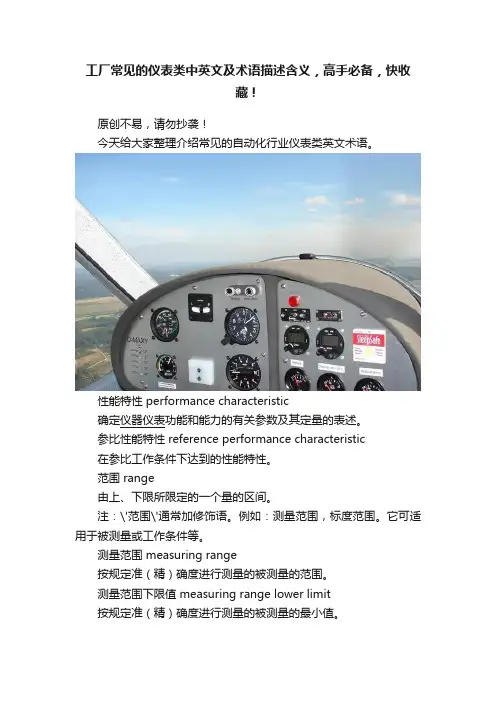
工厂常见的仪表类中英文及术语描述含义,高手必备,快收藏!原创不易,请勿抄袭!今天给大家整理介绍常见的自动化行业仪表类英文术语。
性能特性 performance characteristic确定仪器仪表功能和能力的有关参数及其定量的表述。
参比性能特性 reference performance characteristic在参比工作条件下达到的性能特性。
范围 range由上、下限所限定的一个量的区间。
注:\'范围\'通常加修饰语。
例如:测量范围,标度范围。
它可适用于被测量或工作条件等。
测量范围 measuring range按规定准(精)确度进行测量的被测量的范围。
测量范围下限值 measuring range lower limit按规定准(精)确度进行测量的被测量的最小值。
测量范围上限值 measuring range higher limit按规定准(精)确度进行测量的被测量的最大值。
量程 span范围上限值与下限值的代数差。
例如:范围为-20℃至100℃时,量程为120℃。
标度 scale构成指示装置一部分的一组有序的标度标记以及所有有关的数字。
标度范围 scale range由标度始点值和终点值所限度的范围。
标度标记 scale mark指示装置上对应于一个或多个确定的被测量值的标度线或其它标记。
注:对于数字示值,数字本身等效于标度标记。
零[标度]标记 zero scale mark同义词:零标度线。
标度盘(板)上标有\'零\'数字的标度标记或标度线。
标度分格 scale division任何两个相邻标度标记之间的标度部分。
标度分格值 value of scale division又称格值。
标度中对应两相邻标度标记的被测量值之差。
标度分格间距 scale spacing, length of a scale division沿着表示标度长度的同一线段上所测得的任何两个相邻标度标记中心线之间的距离。
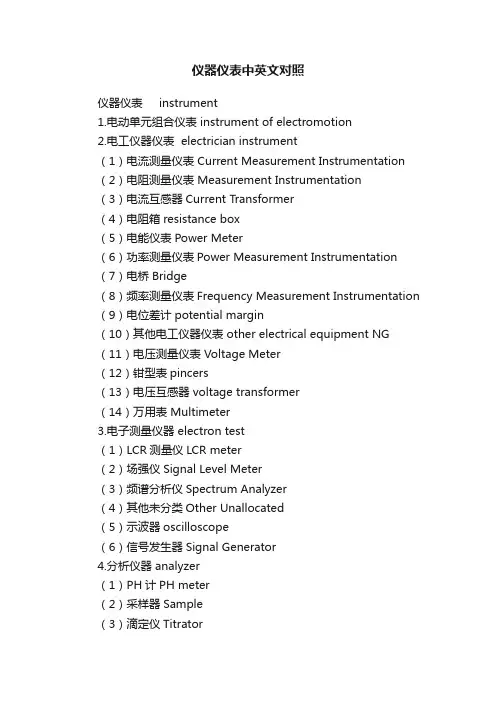
仪器仪表中英文对照仪器仪表 instrument1.电动单元组合仪表 instrument of electromotion2.电工仪器仪表 electrician instrument(1)电流测量仪表 Current Measurement Instrumentation (2)电阻测量仪表 Measurement Instrumentation(3)电流互感器Current Transformer(4)电阻箱resistance box(5)电能仪表Power Meter(6)功率测量仪表Power Measurement Instrumentation (7)电桥Bridge(8)频率测量仪表Frequency Measurement Instrumentation (9)电位差计potential margin(10)其他电工仪器仪表 other electrical equipment NG (11)电压测量仪表 Voltage Meter(12)钳型表pincers(13)电压互感器 voltage transformer(14)万用表 Multimeter3.电子测量仪器 electron test(1)LCR测量仪LCR meter(2)场强仪Signal Level Meter(3)频谱分析仪Spectrum Analyzer(4)其他未分类Other Unallocated(5)示波器oscilloscope(6)信号发生器Signal Generator4.分析仪器 analyzer(1)PH计PH meter(2)采样器Sample(3)滴定仪Titrator(4)电导仪器conductivity equipment(5)定硫仪sulfur meter(6)粒度仪particle size analyzer(7)量热仪calorimeter(8)浓度计T otal concentration(9)其他分析仪器Other instruments(10)气体分析仪Gas Analyzer(11)色谱仪chromatography(12)声级计sound level Total(13)水分计Moisture Meter(14)水质分析仪Water Analyzer(15)粘度计viscosity(16)浊度计 Turbidimeter5.工业计时器 calculagraph of industry6.光学仪器 optical instruments(1)放大镜magnifier(2)分光仪spectrometer(3)光电子、激光器件photonics, laser devices (4)光谱仪、光度计spectrometer, photometer (5)经纬仪、水准仪theodolite, Level(6)棱镜、透镜prism. Lens(7)其他光学仪器other optical equipment (8)色差计colorimeter(9)望远镜telescope(10)显微镜microscopy(11)夜视仪Night Vision(12)折射仪refractometer。

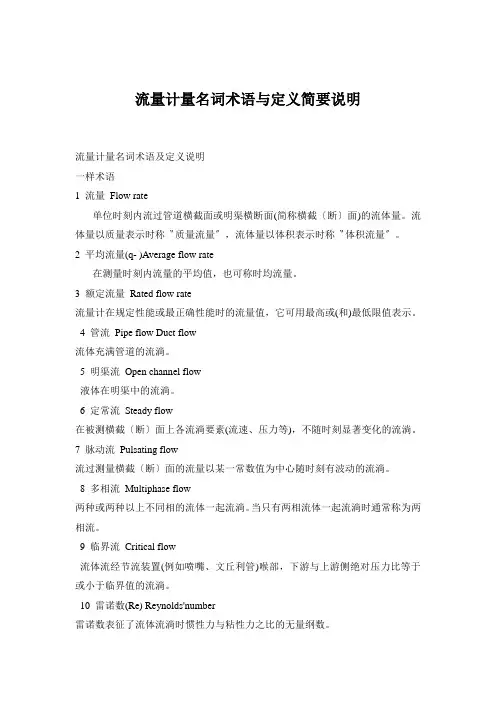
流量计量名词术语与定义简要说明流量计量名词术语及定义说明一样术语1 流量Flow rate单位时刻内流过管道横截面或明渠横断面(简称横截〔断〕面)的流体量。
流体量以质量表示时称〝质量流量〞,流体量以体积表示时称〝体积流量〞。
2 平均流量(q- )Average flow rate在测量时刻内流量的平均值,也可称时均流量。
3 额定流量Rated flow rate流量计在规定性能或最正确性能时的流量值,它可用最高或(和)最低限值表示。
4 管流Pipe flow Duct flow流体充满管道的流淌。
5 明渠流Open channel flow液体在明渠中的流淌。
6 定常流Steady flow在被测横截〔断〕面上各流淌要素(流速、压力等),不随时刻显著变化的流淌。
7 脉动流Pulsating flow流过测量横截〔断〕面的流量以某一常数值为中心随时刻有波动的流淌。
8 多相流Multiphase flow两种或两种以上不同相的流体一起流淌。
当只有两相流体一起流淌时通常称为两相流。
9 临界流Critical flow流体流经节流装置(例如喷嘴、文丘利管)喉部,下游与上游侧绝对压力比等于或小于临界值的流淌。
10 雷诺数(Re) Reynolds'number雷诺数表征了流体流淌时惯性力与粘性力之比的无量纲数。
11 比热比(γ) Specific heat ratio定压比热(cp)与定容比热(cV)的比值。
一样是温度和压力的函数。
12 等熵指数(κ) Isentropic exponent在等熵过程中,气体介质压力相对变化与密度相对变化的比值。
13 气体压缩系数(z) Gas compressibility factor表示气体偏离理想气体性质的程度,一样是温度T和压力p的函数。
14 静压Static pressure在流体中不受流速阻碍而测得的压力值。
15 动压Dynamic pressure流体单位体积具有的动能其大小通常用-12 ρv2运算。
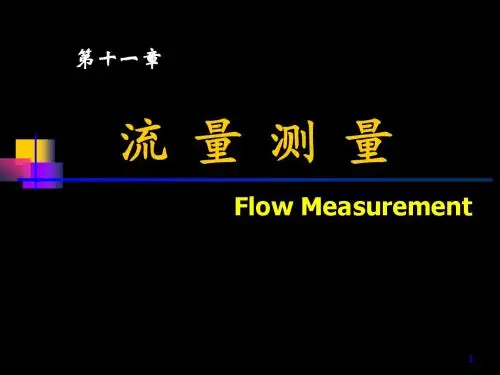
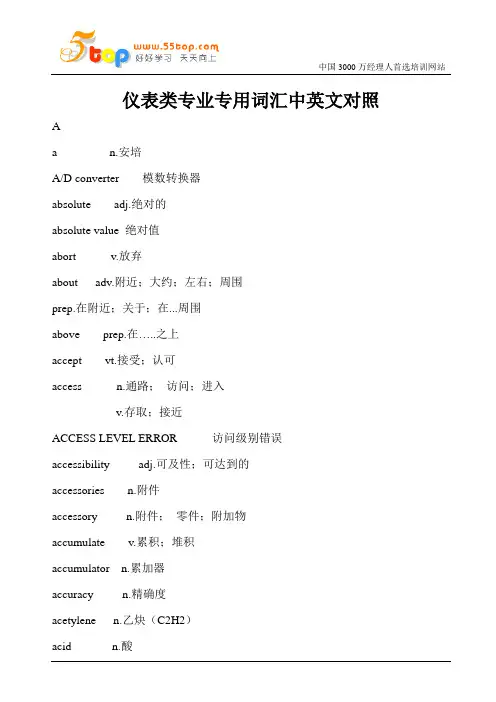
仪表类专业专用词汇中英文对照Aa n.安培A/D converter 模数转换器absolute adj.绝对的absolute value 绝对值abort v.放弃about adv.附近;大约;左右;周围prep.在附近;关于;在...周围above prep.在…..之上accept vt.接受;认可access n.通路;访问;进入v.存取;接近ACCESS LEVEL ERROR 访问级别错误accessibility adj.可及性;可达到的accessories n.附件accessory n.附件;零件;附加物accumulate v.累积;堆积accumulator n.累加器accuracy n.精确度acetylene n.乙炔(C2H2)acid n.酸ACK 确认acquisition n.采集action n.动作active adj.激活的;有源的actuator n.驱动器;执行机构adapt vt.适应;改编;匹配adapter n.适配器add n.增加adder n.加法器additional n.附加adj.附属的, 补充的address n.地址adjust vt.调整administrator n.管理员admissible adj.可容许的advanced adj.先进的;高级的ADVSP(Advisor SP)建议设定值AI(analog input)模拟量输入aided adj.辅助的air n.空气alarm n.报警ALENBST(Alarm Enable State)报警许可状态algorithm n.算法align v.排列;使成一行allow vt.允许ALM ANNC 报警器ALM SUMM 报警汇总aluminum oxide n.氧化铝AM(Application Module)应用模块Ambient adj.周围的;n.周围环境AMP DAMPING 阻尼时间常数AMP TEMP 放大器温度A-MC(Advanced Multifunction Controller)高级多功能控制器amperemeter n.电流表amplifier n.放大器amplitude n.振幅analog adj.模拟的;模拟量analogue n.相似物;类似情况analysis n.分析analyzer n.分析器and n.与门angle n.角annunciator n.信号器;报警器another prep.又一个;另外AO(analog output)模拟量输出APM(Advanced Process Manager)先进过程管理器appearance n.出现;露面;外貌;外观apply vt.应用;申请application n.应用;应用程序;应用软件approach n.方法;途径appropriate adj.适当的Apr.(April) n.四月archive vt.归档area n.区域armoured adj.铠装的arrange v.安排;排列artificial adj.人工的ascending adj.上升的;向上的assembly n.集合;装配;集会;集结;汇编assign vt.分配;赋值assignment n.分配ASSOC DISP 相关画面asymmetry potential 不对称电位asymptotic adj.渐进的at prep.在;于atmospheric adj.大气的attach vt.缚上;系上;贴上attempt n.;vt.尝试;企图attitude n.态度;姿态attractor n.吸引子attribute n.属性Aug.(August) n.八月auto n.自动AUTO LRV 自动设置测量下限值AUTO HRV 自动设置测量上限值automatic adj.自动的automatically adv.自动地;机械地AUTO SET 自动设置AUX SET1 辅助设置Auxiliary Amplifier 辅助放大器available adj.可用到的;可利用的;有用的v.配属;隶属于Bbackflushvalve 反吹阀backgroud n.背景backplane n.底板backtrack vt.回溯backward adj.向后bad adj.坏的BADCTLFL(Bad Control Flag)无效控制标志BADPVPR(Bad PV Priority)坏PV值报警优先级balance n.;v.平衡ball n.球band n.区bargraph n.棒图barrier n.栏栅;障栅base n.基座;库;基本baseline n.基线basic n.基本;基本battery n.电池BC(Basic Controller)基本控制器below adj.下面的benchmark n.基准;标准benefit n.益处;效益;收益best adj.最好的between prep.之间bias n.偏离;偏差bicycle pump 气缸BIDIRE MODE 双向流体测量bilinear adj.双线性的binary adj.二进制的;二元的bit n.位black adj.黑色的blind adj.盲目;瞎blinking adj.闪光的blue adj.蓝色的board n.板body n.身体;本体boiler n.汽锅;锅炉bottom n.底端;末端;尽头box n.盒子;箱子brain n.大脑braking vt.制动bridge n.桥budget n.预算buffer n.缓冲器build vt.建立BURN OUT CPU异常时输出状态bus n.总线button n.按钮butylene n.丁烯buzzer n.蜂鸣器by adv.通过bypass n.旁路byte n.字节Ccabinet n.柜cable n.电缆cable gland n.电缆管calculate v.计算calibrate vt.校验;校准calibration n.校验;标准;刻度calibration solution 校验溶液cancel vt.取消capillary n.毛细管CAPSULE 膜盒温度card n.卡件carrier gas 载气CAS 串级cascade n.串联case n.机壳;盒;箱;外壳;箱;套CASREQ (Cascade Request)串级请求category n.种类;范畴caution n.小心;谨慎;警告cell n.小室;电池;单元;传感器center n.中心centrality n.集中性;中心centrifugal adj.离心的certain adj.确定的CG(Computer Gateway)计算机门路chain n.链change vt.改变;变化channel n.通道characteristic n.特性;特征charge vt.充电;充气chart n.图表chassis n.底板(机架)check vt.检查checking n.校验chemical n.化学;化工choice vt.选择chopper n.斩光器chopper n.断路器chromatogram n.谱图CIDSTN (Control Input Destination) 控制输入目标circuit board n.电路板CISRC (Control Input Source) 控制输入源clamp vt.钳制classical adj.经典的;典型的;标准的clear(CLR) vt.清除click vt.点击clip n.夹子clock n.时钟clockwise(cw)adj.顺时针方向的adj.不变的, 持续的adv. 顺时针方向地close v.关闭CM(Computing Module)计算模块code n.代码;编码CODSTN (Control Output Destination) 控制输入目标参数coefficient n.系数coil n.线圈collection n.采集;收集color n.颜色column n.色谱柱;圆柱column switching valve 柱切阀combine v.(使)联合;(使)结合command n.按钮;指令common adj.共同的;公共的;公有的communication n.通讯compare v.比较;对比compartment n.间隔间compatibility n.相容性;兼容性compensation n.补偿complete adj.完全;vt.完成complex adj.复杂的compliance n.柔顺;顺序component n.组分;adj.组成的composite adj.合成的;混合的;n.合成物composite control n.组合控制composition n.组成;组件compound adj.复合compressor n.压缩机computation n.计算;估计computer n.电脑;计算机concentration n.浓度condensate n.冷凝物condition n.条件;状态confidence n.置信度configuration n.组态;配置connection n.连接;关系;接线;线路connectivity n.连结性consistency n.一致性console n.控制台;操作台constant n.常数;恒量;adj.不变的consumption n.消耗;消耗量contact n.;vt.接触;触点content n.内容;目录CONTCUT (Contact Cut Out)报警接点取消control n.;vt.控制control valve 调节阀controller n.控制器;调节器conversion n.转换convert vt.使转变;转换converter n.转换器;交流器;转换器copy n.;vt.拷贝core n.芯corrdinator n.协调器correct adj.正确的correspond vi.符合;协调;通信;相应cost n.成本;花费counter n.计数器;计算器counterclockwise(ccw) adj.逆时针方向的coupled adj.耦合的courseware n.课件CPC(Critical Process Controller)关键过程控制器criterion n.准则CTLACTN( Control Action) 控制作用方向CTLALGID(ControlAlgorithm Identify)控制算法标志名CTLEQN(Control Equation) 控制方程cubicle n.柜;机柜current n.电流adj.当前的, 通用的cursor n.光标;指针customer n.客户;用户CV(Calculation Value) 计算值cycle n.周期;环vt.警告Ddamage n.损害;伤害v. 招致损害damp n.阻尼damper n.阻尼器;风门;节气阀DAMPING一阶滤波时间常数data n.数据database n.数据库date n.日期DCS(Distribution Control System)分散控制系统dead adj.死亡deadband 死区Dec.(December) n.十二月decentrality n.分散性decentralizationn.分散化decimal adj.十进制的;小数的decision n.决策decomposition n.分解DECONF(Digitally Enhanced Configuration Mode) 数字式增强组态模式Decouplingn.解耦(装置)decrease n.;v.减少de-energize adj.非励磁的default n.缺省(值);默认(值)define vt.定义;详细说明degree n.度delay n.延时;延迟delay relay 延时继电器delete vt.删除demo n.演示density n.密度depth n.深度derivative adj.推导出的description n.描写;形容;种类;描述descriptor n.描述符design vt.设计desired adj.希望的desktop n.桌面destination n.目标;目标文件destination n.目标detail n.细节;详细detailed adj.详细的detection n.检测detector n.检测器determination n.确定develop vt.发展;开发deviation n.偏差device n.装置device n.设备dew point n.露点DHP(Date Hiway Port)数据高速通道端口DI(digital input)数字量输入diagnostics n.诊断diagram n.图表dialog box 对话框diameter n.直径diaphragm n.隔膜;膜片dielectric n.电介质;绝缘体adj.非传导性的differential n.微分differentiate v.区分digital adj.数字的dimension n.尺寸direct adj.直接的;vt.指导;管理;支配disable adj.禁止的;未授权的;失效的disconnect v.拆开;分离;断开discontinuous adj.不连续的discrete adj.离散的discriminant n.判别式disorder n.无序DISP LRV 设置测量范围下限DISP SELECT 指示计显示选择DISP UNIT 工程单位显示设置DISP URV 设置测量范围上限display vt.陈列;展览;显示distribution adj.分散的distributor n.配电盘;分配器disturbance n.打扰;扰动diversity n.多样性divisibility n.可分性division n.分离DO(digital output)数字量输出Documentary adj.文件的documentation n.文件编制domain n.域double adj.双重的;两倍的double adj.两倍的;双的double word 双字download vt.下装drag vt.拖drain vt.排放drift n.漂移drive n.;vt.驱动driver n.驱动器;驱动程序dual adj.对偶的;双重的during prep.在...的期间dynamic adj.动态的;动力的dynamical adj.动力学dynamo n.发电机Eearth n.接地EC(Exterded Controller)扩展控制器editor n.编辑器;编辑effectiveness n.有效eight num.八electric circuit 电路electric adj.电气;电的electrode n.电极electromagnetic adj.电磁的electronic adj.电子的element n.元件;元素;成分effect n.结果;效果;作用;影响effective adj.有效的;被实施的effective amplitude 有效振幅emergency n.紧急情况;紧急事件EMERGENCYSHUTDOWN 紧急停车emulate n.模拟;仿真emulator n.模拟器enable vt.允许;授权enclosure n.围住, 围栏end n.;vt.结束energize vt.励磁engine n.发动机engineer n.工程师engineering n.工程ENGR OUTPUT 工程单位输出enhance vt.增强ensure v.确保;确保;保证enter n.;vt.输入;回车envelope n.密封environment n.环境equation n.方程equilibrium n.均衡equipment n.设备error n.错误;误差ERROR OUT 硬件异常时输出状态estimate n.;vt.估计ethane n.乙烷(C2H6)ethene n.乙烯(C2H4)ethylene n.乙烯EUDESC Enginerring Unit Descriptor工程单位描述evaluation n.评价;赋值example n.例子exchange n.交换机excite vt.励磁exclusive OR 异非门execute vt.执行expand vt.扩展expected adj.希望的;预期的experiment n.实验expert n.专家;能手explanation n.解释explosion n.爆炸explorer n.浏览器export vt.导出expression n.表达式;符号EXT ZERO ADJ 外部调零许可extend vt.扩展external adj.;n.外部的;外部extraction n.抽取;提取;摘要;开方(法)Ffaceplate n.面板factor n.因数;因子factory n.工厂failsafe n.故障保护failure n.故障fall n.;vt.失败;落下;下降false adj.假的fan n.风扇fault n.故障feasibility n.可行性feature n.特征Feb.(February) n.二月feed vt.进料;进feedback n.反馈feedforward n.前馈FID detector 氢焰检测器field n.现场;区域fieldbus n.现场总线filter n.过滤器filtering n.滤波finally adv.最终;最后first n.第一;首先fitting nut n.装配螺母;安装螺母five num.五fix vt.使固定;装置;修理;安装flag n.标志flame arrester n.阻火器flameproof adj.防火的flange n.法兰flash vt.闪光;闪烁floating-point n.浮点float levelmeter n.浮子液位计flow rate 流量flow n.流量;流程;vt.流动flowmeter n.流量计flue gas n.燃料气fluid n.流体;流质adj.流体的;液体的fluid level 液位focus n.焦点folder n.文件夹font n.字体;字型;容器force n.力量;力forecast n.;vt.预测form n.形式format n.格式;形式;vt.格式化forward adj.向前的four num.四framework n.框架frequency n.频率;变频Fri.(Friday) n.星期五front n.前面;面队front panel n.前面板full adj.全部;全的;满的function n.功能;函数function block 功能块furnace n.炉子, 熔炉fuse n.保险;保险丝fuzzy adj.模糊的Ggain n.增益GAINOPT (Gain Option) 增益选择game n.对策gas n.气体gas chromatograph 气相色谱仪gasket n.垫圈, 衬垫gate n.门;闸gate lamp 门灯gateway n.门路gear n.设备;齿轮;调整;传动装置general n.概要;adj.大体的;一般的generalized adj.广义generation n.生成;产生geometric adj.几何的gimbaled n.框架glass electrode 玻璃电极global adj整体的;全局的GPCI(General Purpose Computer Interface)通用计算机接口graph n.图表;曲线gray adj.灰色的green adj.绿色ground n.;vt.地;接地group n.组guide n.指南HH/L SW AP 引压方向halt vt.暂停;停止handle vt.处理;操作hardware n.硬件harmonious adj.和谐的;协调的heat v.加热heater n.加热器help n.帮助hexadecimal n.十六进制;adj.十六进制的HG(Hiway Gateway)高速通道门路HID(Hiway Traffic Director)高速通道交通指挥hierarchical adj.分等级的;层次的;递阶的high n.;adj.高;高的HIGH RANGE 上限HIM(Hiway Traffic Director)高速通道接口模件history n.历史hiway n.高速通道HLPIU(High Level Process Interface Unit)高电平过程接口单元HM(History Module)历史模件hold n.;vt.保持holder n.保持器horizontal adj.地平线的;水平的horn n.蜂鸣器hour n.小时HOUR A VG 小时平均值HRV 上限值hybrid adj.混合的hydraulic adj液动的hydrogen n.氢气hydrogen flame 氢火焰hygrometer n.湿度计Iicon n.图标identify vt.识别;鉴定identical adj.同一的, 同样的idol n.空ignitor n.点火器image n.;vt.图像;映像;映射important adj.重要的impulse n.冲量;脉冲;冲激in adv.进入入口inactive adj.不活跃的;没有激活;死点inch n.英寸incorrect adj.错误的increase vt.增加incremental adj.增加的independent adj.独立的;不受约束的index n.指数indication n.指示indicator n.指示器;指示仪indirect adj.间接的individually adv.个别地inductive adj.电感式的industrial n.工业的industry n.工业;产业inertial adj.惯性的inference n.推理;推理information n.信息inherent adj.固有的;内在的inhibit n.禁止initialization n.初始化;设定初始值initial value 初始值inlet n.入口inner adj.内部的;里面的n.内部INPTDIR (Input Direct) 输入信号作用方向input n.;v.输入insert vt.插入inside adj.内部的;内径instability n.不稳定性install vt.安装installation n.安装;装置instruction n.指令instrument n.仪表;仪器;工具instrument air 仪表风integer n.整数integral n.积分;adj.积分的;完整的integration n.综合integrity n.整体性;完整性intelligence n.智力;智能intelligent adj.智能的intensity n.强烈;剧烈;强度;亮度interaction n.关联;互联;交互interface n.接口;界面interfere n.干涉;干扰interlock n.联锁intermittent adj.断续的;间歇的internal adj.内部的interrupt vt.;n.中断interval n.间隔;时间间隔intrinsical adj.本质的;固有的;内在的invalid adj.无效的invoke vt.调用ion collector 离子收集器IOP 输入开路IS 本安isolate vt.使隔离;使孤立;使绝缘isolation n.隔离item n.项目;条款JJan.(January) n.一月jet n.喷射口jet pipe 喷嘴JOURNAL n.日志Jul.(July) n.七月jump vt.跳变jumper field n.跨接线排Jun.(June) n.六月junction n.连接;接合junction box 接线箱KK (Overall Gain) PID算法的增益key n.键;adj.关键的keep vt.保持keyboard n.键盘keypad n.键区KEYWORD n.关键字knowledge n.知识Lladder n.梯形图lag n.滞后lamp n.灯language n.语言large adj.大的last n.最后;adj.最后的;最近的LASTPV最后一次PV值latching n.闭塞;闭锁;关闭law n.规律LCN(Local ControlNetwork)局部控制网络lead n.超前;导线leadwrie n.导线leakage n.泄漏learning n.学习least adj.最小的left adj.左边legend n.图例lengh n.长度LEPIU(Low Energy Process Interface Unit)低能量过程接口单元level n.级别;电平;液位levelmeter n.物位计;液位计limit n.限制;限度linear n.线性linearization n.线性化link vt.连接liquid n.液体liquid level 液位list n.明细表;表;列表;菜单LLPIU(Low Level Process Interface Unit)低电平过程接口单元LM(Logic Manager)逻辑管理器load vt.装载;n.负载loading n.下载、下装local adj.本地的;局部;就地lock vt.上锁locus n.轨迹LOCUTOFF(Low Cut Off) 低值切除log n.对数;日志;vt.登陆LOG n.报表logic n.逻辑logoff vt.断线;退出系统logon vt.登陆loop n.回路low adj低的;低值的lowcut n.低截止值LOW CUT MODE 低截止模式lower n.下限;低LOW RANGE 实测下限LRL(Low Range Limit) 测量范围低限LRV(lower range value)下限值(显示值) lumped adj.集总的;集中的Mmachine n.机器magnetic n.磁;磁场magnitude n.幅度;幅值main adj.主要的maintainability n.可维护性maintenance n.维护major adj.主要的man n.手动management n.管理manager n.管理器manipulate vt.操作manual adj.手动的;n.手册many adj.很多Mar.(March) n.三月margin n.裕度;裕量mark n.标志;vt.作记号mask n.假象mass n.质量mass spcetrometer 质谱仪master adj.主的mathematical adj.数学的;精确的matrix n.矩阵MAX STAT. P 最大静压maximum n.最大量;adj.最大的May(May) n.五月MC(Multifunction Controller)多功能控制器mean vt.意味measure vt.测量;n.尺寸;测量;方法media n.媒体memory n.内存;记忆;存储器menu n.菜单message n.消息;信息meter n.仪表;米metering tube 定量管methane n.甲烷(CH4)methane converter 甲烷转化器method n.方式表;方式;方法methyl acetylene 甲基乙炔MIN SPAN 最小量程minimal adj.最小的minimum n.最小值;最小化;adj.最小的minus adj.负的;减的minute n.分钟mismatch adj.不匹配的mistake n.错误mobile adj.移动的modal adj.形式的;模式的MODATTR(Mode Attribute)操作方式属性mode n.方式;模式model NO. 型号model n.型号;模型MODEM 调制解调器modifiability n.可修改性modification n.修改;修正MODNUM(Module Number)UCN模件号modulate vt.调整, 调节, (信号)调制modulator n.调制器;调幅器module n.模块Mon(Monday)n.星期一monitor vt.监视;监控;n.监视器motion n.动作motion n.运动motor n.电机mount vt.装配;安装mouse n.鼠标movement n.运动MSG CLEAR 报警信息清除MSG CONFM 报警信息确认multifunction n.多功能multiloop n.多回路multimeter n.万用表multiple adj.多重的;倍数的multiway adj.多路(的);多向(的)Nnegative adj.负的;阴极的network n.网络next n.下一个NIM(Network Interface Module)网络接口模件nine num.九NMODATTR (Normal Mode Attribute) 正常操作方式属性NMODE (Normal Mode) 正常操作方式NO.(number)n.号码;编号NOCINPTS (Number Of Control Input Points) Points 输入个数NOCOPTS (Number Of Control Output Points) Pints 输出个数node n.节点NODENUM (Node Number)UCN 节点号NODETYP (Mode Type) UCN节点类型noise n.噪声non-energize adj.非励磁的nonlinear adj.非线性non-retentive adj.非保持的normal(NR)adj.正常的;正规的;标准的not adv.不;n.非门notice n.通知;布告;注意Nov.(November) n.十一月now n.;adv.现在NTWKNUM (Network Number) UCN网络号null n.零;无效number n.数量;号numerical adj.数值的numerical fault 数值误差Oobject n.目标;对象objective n.目标;adj.客观的occurrence n.发生;出现;事件Oct.(October) n.十月odd adj.奇数的;单数的off adj.关的offline adj.脱机的;离线的offset n.偏差;补偿offuser n.操作工often adv.经常oil n.油;油类on adj.开的one num.一online n.联机;在线式only adv.仅仅;只OOP 输出开路open vt.打开open circuit 断路operate vt.操作operating n.操作;运行operation n.操作;实施;作用operator n.操作员OPFINAL (Output Finally) 最终输出值optimal adj.最优的;最佳的optimum n.;adj.最优的;最适宜的option n.选项optional adj.可选择的;随意的or n.或门;conj.或者orbit n.轨道;轨迹order n.有序;次序;命令ORGANIZATIONAL adj组态的orientation n.定向orifice n.孔板out vi.外出,出去out of 在…范围外outlet n.出口output(OP) n.输出OUTPUT MODE 输出/显示方式outside adj.外面的;外部的out-time 超时oven n.炉子over adv结束;prep.在… 之上;超过overflow n.超值;溢出overload n.;vt.超载override n.超弛overshoot n.超调量overview n.概览;总貌画面overwrite vt.覆盖oxygen n.氧气Ppanel n.仪表板;面板parameter n.参数parallel adj.并行的part n.部分;局部;零件;角色vt.分开;分离;分配vi.分开;断裂;分手adv.部分地;有几分adj.部分的;局部的part assembly drawing 零件装配图part drawing 零件图part finished product 半成品part number n.零件号码part requirement card 零件规格卡片part sectioned view 局部剖视图partial adj.部分的;局部的partial pressure 分压pass vt.通过passive adj.无源地password n.密码past adj.过去地paste n.粘贴path n.通路;路径pattern n.模式pause n.暂停;休止符PC(Personal Computer) 个人计算机PCDM(Personal Computer Data Manager)个人计算机数据管理器PCIM(Personal Computer Interface Module)个人计算机接口模件PCSI(Personal Computer Serial Interface)个人计算机串行接口peak n.峰peer-to-peer 点对点per prep.每percent n.百分数performance n.性能;执行period n.周期periodically adv.周期地personal adj.个人的phase n.相位physically adv.物理地picture n.画;图画;描述;vt.画;描绘pipe n.管道PLC(programmable logical controller)可编程逻辑控制器PLCG(Programmable Logic Controller Gateway)可编程逻辑控制器门路plan n.计划platform n.惯性;平台PM(Process Manager)过程管理器pneumatic adj.气动的pneumatically operated valve 气动阀PNTFORM (Point Form) 点形式PNTMODTY (Point Module Type) 点所在模件类型PNTTYPE (Point Node Type) 点所在UCN节点类型point n.点polarizer n.极化器pole n.杆;极点port n.端口pose n.姿势;位姿positioner n.定位器positioning n.定位positive adj.正的;阳的possible adj.可能的power n.电源;动力pre- 事先的prediction n.预测;预估preset vt.预先设定press vt.按;压press regulator 压力调节器PRESS UNIT 差压单位pressure n.压力pressure gauge 压力表prevent v.防止;预防preview vt.预览principle n.原理print n.;vt.打印PRIOR DISP 前次画面显示priority n.先;前;优先;优先级privilege n.特权probe n.探头problem n.问题proceed vi.进行;继续下去process n.过程;vt.处理processor n.处理器profit n.利润program n.程序;vi.编程programmable adj.可编程的project n.工程;项目propadiene n.丙二烯propane n.丙烷(C3H8)property n.属性proportion n.比例propylene n.丙烯(C3H6)protect vt.保护protocol n.协议PTDESC (Point Descriptor) 点描述PTEXECST (Point Execute Status) 点执行状态PTINAL (Point in Alarm) 点处于报警状态pulse n.脉冲pump n.泵purge vt.吹扫purpose n.目的;目标PV(process variable)过程变量PV ALDB (PV Alarm Deadband) PV报警死区PV ALDBEU (Pv Alarm Dead Band In PV) PV报警死区工程单位PV AUTO PV自动PVCALC (PV Calculate) PV计算值PVCHAR(PV Characterization) PV特性PVCLAMP (PV Clamp)PV钳制PVEUHI (PV Eu High)PV工程单位上限PVEULO (PV EU Low)PV工程单位下限PVEXEUHI (PV Extend EU High) PV工程单位扩展上限PVEXEULO (PV Extend EU Low) PV工程单位扩展下限PVFORMAT (PV Format) PV显示格式PVHHTP (PV High high Tip) PV高高值报警限PVHITP (PV High Tip) PV高值报警限PVLOTP (PV Low Tip) PV低值报警限PVLLTP (PV Low Tip) PV低低值报警限PVP (PV in percent) PV的百分比值PVRV (PV Raw Value) PV原值PVSOURCE (PV Source) PV源PVSRCOPT (PV Source Option) PV源选择PVSTS (Status Of PV) PV状态PVTEMP (PV Temperature Scale) PV的温度特性PVTRACK (PV Track)PV跟踪PVTV (PV Target Value) PV目标值QQ band Q波段Q meter 品质因数表Q switch 光量开关quality n.质量quenchoil n.急冷油quenchwater n.急冷水quickview vt.快速查看quit vt.离开;放弃;解除;停止Rrack n.机架radiation n.辐射rail n.导轨random adj.随机的range n.量程;范围rate n.比率;速率ratio n.比值raw adj.原生的reaction n.反应read vt.读read-only 只读ready adj.准备完毕的;现成的realization n.实现real-time 实时的reason n.原因;推理receive vt.收到;接收receptacle n.插座recognition n.识别recommend vt.推荐;介绍record n.;vt.记录recorder n.记录仪recorder output 记录仪输出red adj.红色redundancy n.冗余redundant adj.冗余的refer vt.提交;谈及reference n.参考refresh v.更新;恢复region n.域register n.寄存器regulate vt.调节;控制;校准regulation n.调节regulator n.调节器relative adj相对的;有关系的relay n.中继;继电器release vt.释放remain vi.保持;残留remote adj.远程的;远传的removable adj.可移动remove vt.移动repair vt.修理replace vt.替换report n.报告request n.;vt.请求reset vt.复位resident n.;adj.驻留;驻留的resistance n.电阻;阻抗resource n.资源respond v.响应;反应response n.响应restricted adj.受限制的;有限的restriction orifice 节流孔板restrictor n.气阻;电阻result n.结果retain vt.保持retention time 保留时间retentive adj.保持的retrieval n.检索;恢复retry v.再试;重试REV OUTPUT 输出反向reverse adj.相反的;反向的review vt.复查right adj.右的risk n.风险robot n.机器人robust n.鲁棒rotameter n.浮子流量计;转子流量计rotor n.转子rule n.规则run n.;vt.运行rung n.阶梯Ssafe adj.安全的safety n.安全;保险装置safety barrier 安全栅same adj.相同的sample n.例子;vt.取样;采样sampling valve 取样阀sampling n.采样Sat.(Saturday) n.星期六saturation n.饱和save v.保存;存储scale n.规模;范围scan vt.浏览;扫描SCHEM ab.流程图schematic n.流程图science n.科学screen n.屏幕scroll n.滚动search vt.搜索;寻找seat n.座second(sec)n.秒;第二secondly adv.第二;其次section n.部分;部件;区;截面SECV AR (Secondary Variable) 次变量。
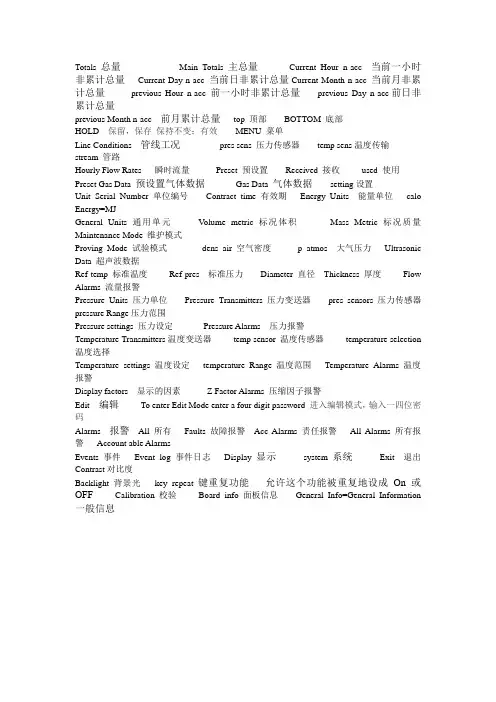
Totals 总量Main Totals 主总量Current Hour n-acc 当前一小时非累计总量Current Day n-acc 当前日非累计总量Current Month n-acc 当前月非累计总量previous Hour n-acc 前一小时非累计总量previous Day n-acc前日非累计总量previous Month n-acc 前月累计总量top 顶部BOTTOM 底部HOLD 保留,保存保持不变;有效MENU 菜单Line Conditions 管线工况pres sens 压力传感器temp sens温度传输stream 管路Hourly Flow Rates 瞬时流量Preset 预设置Received 接收used 使用Preset Gas Data 预设置气体数据Gas Data 气体数据setting设置Unit Serial Number 单位编号Contract time 有效期Energy Units 能量单位calo Energy=MJGeneral Units通用单元V olume metric 标况体积Mass Metric 标况质量Maintenance Mode 维护模式Proving Mode 试验模式dens air 空气密度p atmos 大气压力Ultrasonic Data 超声波数据Ref temp 标准温度Ref pres 标准压力Diameter 直径Thickness 厚度Flow Alarms 流量报警Pressure Units 压力单位Pressure Transmitters 压力变送器pres sensors 压力传感器pressure Range压力范围Pressure settings 压力设定Pressure Alarms 压力报警Temperature Transmitters温度变送器temp sensor 温度传感器temperature selection 温度选择Temperature settings 温度设定temperature Range 温度范围Temperature Alarms 温度报警Display factors 显示的因素Z Factor Alarms 压缩因子报警Edit 编辑To enter Edit Mode enter a four digit password 进入编辑模式,输入一四位密码Alarms 报警All 所有Faults 故障报警Acc Alarms 责任报警All Alarms 所有报警Account able AlarmsEvents 事件Event log 事件日志Display 显示system 系统Exit 退出Contrast对比度Backlight 背景光key repeat 键重复功能允许这个功能被重复地设成On 或OFF Calibration 校验Board info 面板信息General Info=General Information 一般信息。
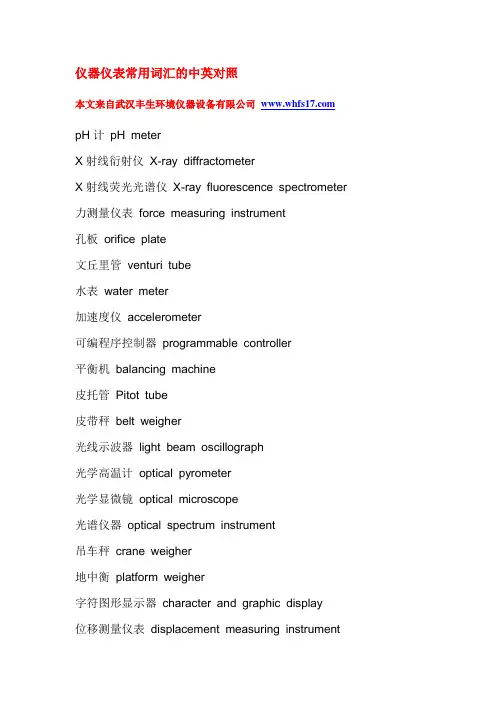
仪器仪表常用词汇的中英对照本文来自武汉丰生环境仪器设备有限公司 pH计pH meterX射线衍射仪X-ray diffractometerX射线荧光光谱仪X-ray fluorescence spectrometer 力测量仪表force measuring instrument孔板orifice plate文丘里管venturi tube水表water meter加速度仪accelerometer可编程序控制器programmable controller平衡机balancing machine皮托管Pitot tube皮带秤belt weigher光线示波器light beam oscillograph光学高温计optical pyrometer光学显微镜optical microscope光谱仪器optical spectrum instrument吊车秤crane weigher地中衡platform weigher字符图形显示器character and graphic display位移测量仪表displacement measuring instrument巡迴检测装置data logger波纹管bellows长度测量工具dimensional measuring instrument长度传感器linear transducer厚度计thickness gauge差热分析仪differential thermal analyzer扇形磁场质谱计sector magnetic field mass spectrometer 料斗秤hopper weigher核磁共振波谱仪nuclear magnetic resonance spectrometer 气相色谱仪gas chromatograph浮球调节阀float adjusting valve真空计vacuum gauge动圈仪表moving-coil instrument基地式调节仪表local-mounted controller密度计densitometer液位计liquid level meter组装式仪表package system减压阀pressure reducing valve测功器dynamometer紫外和可见光分光光度计ultraviolet-visible spectrometer顺序控制器sequence controller微处理器microprocessor温度调节仪表temperature controller煤气表gas meter节流阀throttle valve电子自动平衡仪表electronic self-balance instrument 电子秤electronic weigher电子微探针electron microprobe电子显微镜electron microscope弹簧管bourdon tube数字式显示仪表digital display instrument热流计heat-flow meter热量计heat flux meter热电阻resistance temperature热电偶thermocouple膜片和膜盒diaphragm and diaphragm capsule调节阀regulating valve噪声计noise meter应变仪strain measuring instrument湿度计hygrometer声级计sound lever meter黏度计viscosimeter转矩测量仪表torque measuring instrument转速测量仪表tachometer露点仪dew-point meter变送器transmitter仪器仪表常用术语中英文对照带注释版性能特性 performance characteristic :确定仪器仪表功能和能力的有关参数及其定量的表述。
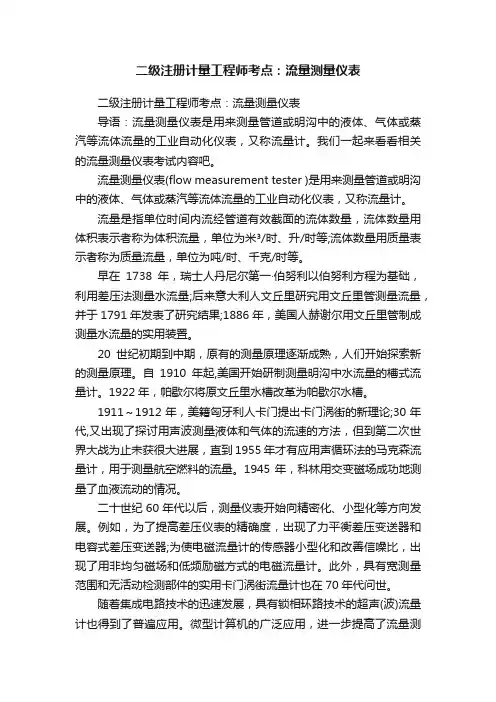
二级注册计量工程师考点:流量测量仪表二级注册计量工程师考点:流量测量仪表导语:流量测量仪表是用来测量管道或明沟中的液体、气体或蒸汽等流体流量的工业自动化仪表,又称流量计。
我们一起来看看相关的流量测量仪表考试内容吧。
流量测量仪表(flow measurement tester )是用来测量管道或明沟中的液体、气体或蒸汽等流体流量的工业自动化仪表,又称流量计。
流量是指单位时间内流经管道有效截面的流体数量,流体数量用体积表示者称为体积流量,单位为米³/时、升/时等;流体数量用质量表示者称为质量流量,单位为吨/时、千克/时等。
早在1738年,瑞士人丹尼尔第一·伯努利以伯努利方程为基础,利用差压法测量水流量;后来意大利人文丘里研究用文丘里管测量流量,并于1791年发表了研究结果;1886年,美国人赫谢尔用文丘里管制成测量水流量的实用装置。
20世纪初期到中期,原有的测量原理逐渐成熟,人们开始探索新的测量原理。
自1910年起,美国开始研制测量明沟中水流量的槽式流量计。
1922年,帕歇尔将原文丘里水槽改革为帕歇尔水槽。
1911~1912年,美籍匈牙利人卡门提出卡门涡街的新理论;30年代,又出现了探讨用声波测量液体和气体的流速的方法,但到第二次世界大战为止未获很大进展,直到1955年才有应用声循环法的马克森流量计,用于测量航空燃料的流量。
1945年,科林用交变磁场成功地测量了血液流动的情况。
二十世纪60年代以后,测量仪表开始向精密化、小型化等方向发展。
例如,为了提高差压仪表的精确度,出现了力平衡差压变送器和电容式差压变送器;为使电磁流量计的传感器小型化和改善信噪比,出现了用非均匀磁场和低频励磁方式的电磁流量计。
此外,具有宽测量范围和无活动检测部件的实用卡门涡街流量计也在70年代问世。
随着集成电路技术的迅速发展,具有锁相环路技术的超声(波)流量计也得到了普遍应用。
微型计算机的广泛应用,进一步提高了流量测量的能力,如激光多普勒流速计应用微型计算机后,可处理较为复杂的'信号。
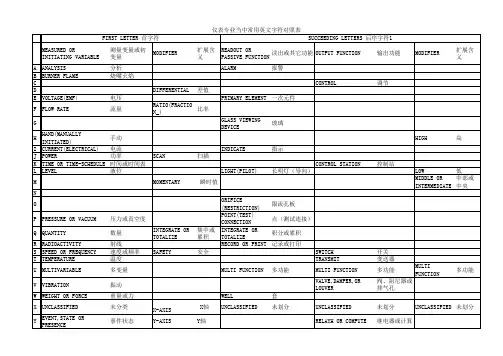
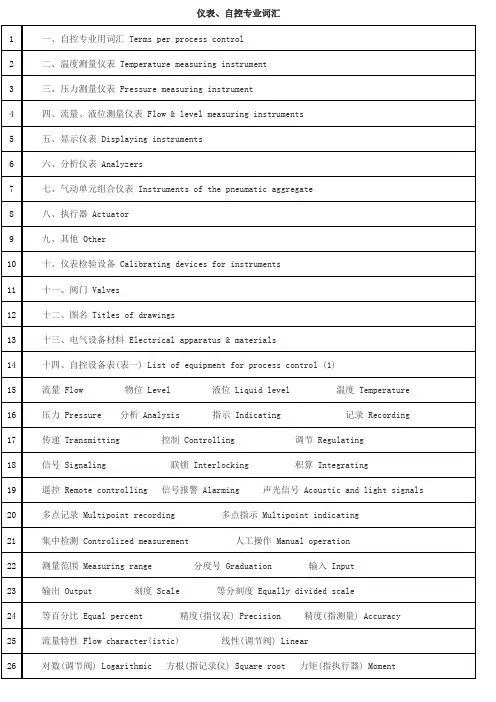
仪表专业英语词汇Process measurement and control instrument 工业自动化仪表Thermometer 温度计Thermometer element 测温元件Thermometer wire 热电偶丝Measuring junction 测量端Extension wire 补偿端Reference wire 基准点Emf measuring device 热电势测量表Element with double insulators 带双孔绝缘子元件Element with asbestos insulators 带石棉绝缘子元件Connection head 接线盒Angle fitting 弯头Protecting tube 保护管Ceramic insulator 陶瓷绝缘子Terminal block 端子块Conduit 导线管Thermocouple Thermometer 热电偶温度计Resistance thermometer 电阻温度计Resistance winding 电阻绕组Vibration proof tube 防震管Mounting thread 安装螺纹接头Terminal 端子Head cover 接线盒盖Rating plate / name plate铭牌Rubber packing 橡皮垫Water proof plug 防水塞Thermistor 感温元件Lead wire 引线Head mount temperature transmitter 顶装式温度变送器Field mount temperature transmitter 现场安装式温度变送器Rail mount (control room) temperature transmitter 轨道安装式(控制室)温度变送器Head mount (integral) temperature transmitter with LCD meter顶装式(一体化)带液晶显示表温度变送器Electronics module 电子模块Sanitation type thermo well 卫生型温度计套管Flanged thermo well法兰连接的温度计套管Weleded thermo well 焊接连接的温度计套管Threaded thermo well 螺纹连接的温度计套管Armored sensor (thermocouple or resistance) 铠装感温元件(热电偶或热电阻)Standard extension 标准延长管Nipple -union -nipple extension 活接头和两根短管组成的延长管Spring loaded armored sensor 带弹簧压紧的铠装感温元件(热电偶或热电阻)Terminal block armored sensor 带端子块的铠装感温元件(热电偶或热电阻)Flying lead armored sensor不带端子块的铠装感温元件(热电偶或热电阻)Nipple-union extension 短管和活接头组成的延长管Cover with wiring diagram label 带接线简图的变送器盖Housing with permanent terminal block 带端子块的变送器壳LCD meter 液晶显示表Cover with glass 带玻璃面板的变送器盖Radiation pyrometer 辐射高温计/光学高温计Filled system thermometer 压力式温度计Bimetallic thermometer 双金属温度计Bimetallic sensor双金属感温元件Capillary tubing 毛细管Thermal system bulb温包Filling fluid 充填介质Jam nut 锁紧螺母Housing 表壳Pointer 指针Scale /Dial 刻度盘Bourdon tube 弹簧管Actuating unit传动机构Finned bulb 翅片式温包Short coil bulb 短圈温包Long bulb长圈温包Protect bulb带保护套管温包Wall mounting bulb 壁装温包Instrument case 外壳Sealing ring密封圈Circle nut 圆螺母Male thread connector 外螺纹接头Rotating axis 转轴Protecting tube外保护管Protective sleeve内保护管Adjustment –angle spring 转角弹簧Spindle心轴Pneumatic liquid level controller 气动液位调节器Displacer 浮筒Range spring 量程弹簧Enclosing tube 密封管Magnet 磁极Attraction 吸引球Flapper挡板Cam凸轮Pliot nozzle 先导放大器喷嘴Indictor 指针Zero adjustment 零位调节螺钉Proportional band adjustment 比例带调节螺钉Proportional band spring 比例带弹簧Reset bellows 重定波纹管Exhaust valve 排气阀Orifice 孔板Supply air gauge 供气压力表Filter regulator 过滤器减压阀Actuating lever 作用力杠Set point adjustment 设定点调节螺钉Feed back bellows 反馈波纹管Reset valve 重定阀?Relay 继电器Output gauge 输出压力表Cage 浮筒室Control valve 控制阀Pneumatic displacer liquid level controller气动浮筒液位调节器Pneumatic float boll liquid level controller气动浮球液位调节器Attraction sleeve 吸引套筒Hex nut 六角螺母Stem支杆Stem retaining bracket 支杆室Screw 螺钉Bracket 支架Cotter pin 固定销针Washer垫圈Pivot pin 芯轴Lock washer 锁紧垫圈Float 浮球Body 壳体E-tube gasket 管用E型垫片Scale spans 标度Battery 电池Rheostat变阻器Swatch开关Ammeter 电流表Prisms棱镜Ocular lens 目镜Comparison lamp对比灯Level controller and switches 液位调节器及液位开关External cage-mounted ball float controller 外浮球式液位调节器Controller 调节器Counterweight 平衡重锤Float actuated level valve 浮球驱动液位控制阀Ball float with pilot valve带先导阀的浮球液位调节器Balanced control valve 平衡型控制阀Pilot valve 先导阀Reduction mechanism 变换结构Magnetically actuated displacer switch磁动式浮筒液位开关Magnetic armature衔铁Permanent magnet永久磁铁Tension (return) spring拉力(复位)弹簧Magnetically actuated ball-float switch磁动式浮球液位开关Transmitter变送器Float level transmitter 浮球液位变送器Magnetically coupled displacer unit磁力耦合式浮筒装置Drive magnet驱动磁体Magnet follow随动磁铁Distant indicator远距离指示器Two phase induction motor(reversing)两相感应电动机(可逆电动机) Air pilot 气动放大器Pressure instrument压力测量仪表Pressure gauge with electric connector电接点压力表Pressure switch压力开关Connection接头Adjustment调节柱Spring ring弹簧圈Shaft protecting sleeve 轴套Insulate sheath 绝缘套管Conduct screw 导电螺钉Seal gasket密封垫圈Hexagon socket head screw 圆柱头内六角螺钉Leading cable 引入电缆Thin gasket薄垫片Adjustment rod调节杆Bellows波纹管Lever杠杆Micro-switch微动开关Balance spring平衡弹簧Deviation spring差动弹簧Radar electronics module雷达电子模块Operating and display module操作与显示模块HF module高频模块Adopter for housing complete with o-ring带o型圈的表头适配器Flange assembly 法兰组件Locking screw锁紧螺钉Ground terminal接地端子Datum point for measurement 测量基准点Waveguide导波管Alumina氧化铝陶瓷Teflon vapor seal四氟塑料气封SST window ring不绣钢窗环O-ring o型环Process O-ring 工艺连接o型环Spiral-wound gasket(non-wetted)缠绕垫(不接触介质)Process flange工艺连接法兰Bourdon tube pressure gauge 弹簧管(波登管)压力表Process connection工艺过程测量接头Hairspring 游丝Spiral tube pressure gage 螺旋管压力表Stiff diaphragm gage硬质膜片压力表Diaphragm膜片Protecting diaphragm 保护膜片Slack diaphragm pressure gage低程膜片压力表Annular diaphragm环形膜片Pressure inlet压力入口Capsule pressure gage膜盒压力表Corrugated diaphragm波纹膜片Diaphragm stack膜片组High pressure bellows manometer 高压波纹管式压力表Free end自由端Stop限位止挡Flexible metal strip 弹性金属片Micrometer gage微压表Remote pressure gage 遥测压力表Pressure tap取压口Slide wire resister滑线电阻Indicating unit指示装置Absolute pressure bellows indicator波纹管绝对压力计Process bellows测量波纹管Piston活塞Tested gage受验压力表Weight砝码Cover O-ring 盖上0-型密封圈Span and zero adjustment量程和零点调节Electronics board 电子板Module O-ring模块上0-型密封圈Sensor module传感器模块Process connector工艺连接Electric connector电气连接Label标签Channel for mounted bolt 安装螺栓槽Lower range value下限值Increase damping增加阻尼Decrease damping减少阻尼Write over interlock写入过量连锁Isolate diaphragm隔离膜片Sensing diaphragm传感膜片Test instrument测试仪表Microprocessor-base electronics基于微处理的电子模块Pressure transmitter 压力变送器Radar level meter雷达液位计Field installed type of pressure indicating and controller基地式压力指示调节器Set point adjustment knob 设定点调节旋钮Nozzle block喷嘴Resistance unit阻尼部件Proportional reset mechanism 比例积分机构Differential gap mechanism 差动间隙机构Controlled variable被测变量Proportional bellows比例波纹管Over range lever超程杠杆Bourdon plate tension spring 弹簧板拉簧Proportional band adjustment knob比例度调节旋钮Proportional leaf spring比例簧片Flapper挡板Index post screw 整定螺丝Set point scale设定值刻度盘Set point scale alignment screw 设定值标尺调整螺丝Alignment spring 调整弹簧Differential –gap adjustment knob 差动间隙调节旋钮Pilot block放大器组件Exhaust block排气组件Booster relay功率放大器Protecting the gauge against fluctuating压力表阻尼保护Restriction hole节流孔Pressure gauge connection / Gauge coupling压力表接头Snubber减震接头Isolating valve 隔离阀Flanged diaphragm gauge 法兰式膜片压力表Gauge valve 压力表阀门Adaptor 转换接头Gauge cock压力表旋塞阀Tee三通De-pressurizing valve 泄压阀Sealing pot 隔离罐Siphon冷凝弯管Pig tail type siphon回弯冷凝管Pulsation damper缓冲罐Gamma radiometric level meter 伽马射线液位计Source container伽马射线源密封盒Source伽马射线源Detector检测器Detector head检测器头Temperature sensor 温度传感器Photomultiplier光电倍增器Scintillation rod produces flashes when gamma radiation impinges on it 当伽马射线照射它时,火花棒就闪烁Outer stainless steel encapsulation不绣钢外套Reference diode参照用的发光二极管Connection to transmitter连接至变送器Measured value display showing level in %at VoHo 在VoHo 矩阵点处显示的以百分数表示的液位测量值Bar chart棒图Matrix selection keys 矩阵点选择键Parameter entry keys参数输入键Green communications LED—lights when communication 绿色通讯发光二极管—通讯时灯亮Alarm relay LED—lights on fault condition , relay de-energies Matrix position indicator报警继电器发光二极管—事故时继电器失电,灯亮Limit relay LED –red lit , relay de-energies green lit ,elay energisued 极限继电器发光二极管—继电器失电红灯亮,继电器得电绿灯亮Matrix position indicator 矩阵点位置显示Commulog sokets通讯插口Test sockets for 0/4..20 mA ,analogue output 0/4..20毫安模拟量输出测试插口Coriolis mass flow meter 科氏力质量流量计Coriolis mass flow meter sensor 科氏力质量流量计传感器Supporter支架Measure tube测量管Gasket垫片Plug插头Cable connect电缆接头Electromagnetic phase shift detector 电磁式相位检测仪Exciter励磁系统Torsion mode balanced 自平衡系统Single curved tube单弯管Single straight tube单直管Two straight tubes双直管Two slightly curved tubes双微弯管Terminal area端子室Cover of the transmitter connection housing 变送器接线室盖Power supply cable gland电源电缆密封部件Signal cable gland信号电缆入口密封部件Sensor to transmitter special cable gland 传感器到变送器的专用电缆入口密封部件Remote version transmitter coriolis mass flow meter分体变送器型科氏力质量流量计Transmitter connection housing 变送器接线室Allen screws爱伦螺丝(锁紧螺丝)Cover of the electronics area of the transmitter housing 变送器电子部件室盒盖Mounting screws of display module显示模块装配螺丝Plug of the ribbon cable of display module显示模块带状电缆插头2-pole plug of the power supply cable 电源电缆两极插头Electrode signal cable电极信号电缆Coil current cable励磁线圈电流电缆Transmitter electronics board 变送器电子板Replaceable data module 可替换数据的模块Sensor connection housing传感器接线室Primary flow element 一次测量元件Higher pressure side 高压侧Lower pressure side低压侧Sensing diaphragm 传感膜片Over range diaphragm 过载膜片Measure body测量体User installation flange/gasket用户安装法兰/垫片Measure unit trademark 测量机构标牌Hanger挂钩(浮筒)Control link调节杆Torque tube扭力杆Complete steam jacketing蒸汽夹套式Concentric orifice plate 同心孔板Vent排气孔Drain排掖孔Segmental orifice plate 圆缺孔板Eccentric orifice plate偏心孔板Sharp square edge孔板锐边Flow direction流向Flow nozzle流量喷嘴Venture tube文丘里管Throat文氏管喉口Gentile tube 坚梯耳管Dall tube 道尔管Annubar tube阿牛巴管Sensing probe (upstream tube)上游管检测头Sensing bar (downstream tube)下游管检测头Low-pressure connection低压接头High-pressure connection高压接头Laminar flow element层流元件Filter过滤器Straightening vans 导直管Main matrix metering section 主要列阵计量段Downstream housing 下游壳体Upstream tap上游取压口Downstream tap下游取压口Hose nipple软管接头Elbow taps肘管取压Pressure tap取压接头Pitot tube皮托管Static pressure hole 静压口High-pressure impact hole动压口Flow direction indicator流量指示器Gate valve 闸阀Pitot-venturi tube 文丘里皮托管Gilflo meter诘而福罗流量计Static control member 静压调节件Over range stop超程止挡Measuring orifice at no flow 无流量时的检测孔板位置Measuring orifice at a flow 有流量时的检测孔板位置Differential pressure taps 差压取压点Difference pressure transmitter for flow measurement流量测量用差压变送器Fluid velocity meter 流速式流量计Vortex flow meter 旋涡式流量计Sensor assembly敏感元件组件Vortex shedding element旋涡接头Mechanical connector机械接头Locally mounted direct reading level gauges直读式就地液位指示仪Tubular gauge glass 玻璃管液位计Reflex level gauge反射式液位计Transparent level gauge透光液位计Armored magnetic level gauge金属管磁浮子液位计Magnetic steering device磁导向机构Non-frosting type level gauge防霜式液位计Heating type level gauge加热式液位计Jacket steam pipe夹套蒸汽管Hydrostatic level-measuring system 静压式液位测量系统Condensate pot凝液罐Differential pressure measuring element 差压测量元件Direct hydrostatic head type level gauge直接静压头液位计Air-bubble system hydrostatic head level gauge吹气静压液位计Tape float level gauge 钢带浮标液位计Guide wire导向绳Tape钢带Sheave滚轮Gauge head表头Magnetic-bond float gauge磁力耦合浮子液位计Non-magnetic guide tube非磁性导向管Follower magnet随动磁铁Amp unit 放大单元Pick-off coil 感应线圈Fan type inferential meter 叶轮式流量表Preamp (preamplifier)前置放大器。
索引A确认报警Acknowledging alarms 27调整仪表系数Adjusting meter factors 48报警菜单Alarm menu 26报警优先权,状态指示器Alarm priorities, status indicator 27 报警Alarms确认acknowledging 27事件events高报警值high alarm 45低报警值low alarm 45状态status 91查看viewing 26模拟接线Analog wiring 10B拾感器电压错误Bad pickoff voltage 98基本质量单位Base mass unit 42基本时间单位Base time unit 42基本单位Base unit 42基本体积单位Base volume unit 42猝发模式Burst mode 70C标定Calibrating 78故障failure 89如何进行标定how to calibrate 78排除故障troubleshooting 96何时进行标定when to calibrate 78用ProLink II with ProLink II 83用HART手操器with the HART Communicator 79改变Changing阻尼值damping values 46密度阻尼density damping 47密度单位density units 40显示器选项display options 54显示器滚动速率display scroll rate 55显示变量display variables 56故障输出fault output频率输出frequency output 66mA输出mA output 62流量阻尼flow damping 46流量方向flow direction 52团状流量上限值high slug-flow limit 49团状流量下限值low slug-flow limit 49量程下限值lower range value 61小流量切除值low-flow cutoff质量流量mass flow 51体积流量volume flow 51mA故障输出mA fault output 62mA输出阻尼mA output damping 62质量流量单位mass-flow units 37仪表系数meter factors 48离线密码off-line password 55输出标度output scale 63脉宽pulse width 67团状流量持续时间slug-flow duration 50团状流量的限定slug-flow limits 48软件标识符software tag 53温度阻尼temperature damping 47温度单位temperature units 41量程上限值upper range value 59体积流量单位volume-flow units 38特征化Characterizing 75FCF参数FCF parameter 77如何进行特征化how to characterize 76排除故障troubleshooting 95何时进行特征化when to characterize 75用ProLink II with ProLink II 77用HART手操器with the HART Communicator 76检查测试点Checking the test points 96显示器的命令数Command tree for the display 116通讯回路,排除故障Communication loop, troubleshooting 94变送器部件Components of the transmitter 5连接ProLink II Connecting ProLink II 111, 112, 113, 114 连接HART手操器Connecting the HART Communicator 107 与客户服务部门的联系方法Contacting customer service 98 约定Conventions 108转换系数Conversion factor 42客户服务,联系Customer service, contacting 98D阻尼Damping密度阻尼density damping 47流量阻尼flow damping 46mA输出mA output 62温度阻尼temperature damping 47值values 46密度Density仪表系数meter factor 48密度标定Density calibration 78密度阻尼,改变Density damping, changing 47密度单位Density units改变changing 40列表list 40数字通讯Digital communications 100禁止显示器参数Disabling display parameters 54显示器Display报警菜单alarm menu 26报警alarms确认acknowledging 27查看viewing 26改变量程下限值changing lower range value 61改变输出标度changing output scale 65改变量程上限值changing upper range value 60改变变量changing variables 56命令树command tree 116部件components 13, 115允许/禁止参数enabling/disabling parameters 54回路测试loop test 17mA和频率范围值mA and frequency range values 73选项options 54复位质量累积器resetting mass totalizer 32复位体积累积器resetting volume totalizer 33转动rotating 12滚动速率scroll rate 55启动所有总量starting all inventories 31启动所有累积器starting all totalizers 31停止所有总量stopping all inventories 31停止所有累积器stopping all totalizers 31, 32查看质量总量viewing mass inventory 30查看质量累积器viewing mass totalizer 28查看被测变量viewing process variables 25, 26查看体积总量viewing volume inventory 30查看体积累积器viewing volume totalizer 29调零zeroing 21驱动增益Drive gain不稳定erratic 97E电气连接Electrical connections 99EMI效应EMI effects 101允许显示器参数Enabling display parameters 54环境影响Environmental effects 101环境限制Environmental limits 101环境要求Environmental requirements 1驱动增益不稳定Erratic drive gain 97事件Events定义definition 45设置setting 45报警类型alarm type 45被测变量process variable 45设定值setpoint 45驱动增益过大Excessive drive gain 97F故障状态Fault conditions 91故障输出,改变Fault output, changing频率输出frequency output 66mA输出mA output 62FCF参数FCF parameter 77流量阻尼,改变Flow damping, changing 46流量方向,改变Flow direction, changing 52流量计Flowmeter标定calibrating 78流量计,特征化Flowmeter, characterizing 75频率输出,改变Frequency output, changing故障输出fault output 66输出标度output scale 63脉宽pulse width 67频率范围值Frequency range values 73频率/脉冲输出特性Frequency/pulse output characteristics 100 功能特性Functional specifications 99保险丝Fuse电源power supply 100 HHART猝发模式burst mode 70允许/禁止enabling/disabling 70设置settings 71菜单树menu tree 108多点接线multidrop wiring 11轮询地址polling address 95单回路接线single-loop wiring 10HART手操器HART Communicator指定变量assigning variables 57, 59猝发模式burst mode 70, 71用…标定calibrating with 79改变changing密度阻尼density damping 47密度单位density units 40显示器滚动速率display scroll rate 55显示变量display variables 56故障报警延迟fault timeout 68流量阻尼flow damping 46流量方向flow direction 52频率故障输出frequency fault output 67团状流量限定high slug-flow limit 49团状流量下限low slug-flow limit 49量程下限值lower range value 61mA阻尼mA damping 62mA 故障输出mA fault output 63mA 输出阻尼mA output damping 62质量小流量切除值mass low-flow cutoff 51质量流量单位mass-flow units 37离线密码off-line password 55输出标度output scale 63, 64轮询地址polling address 72pulse wid脉宽h 67RS-485设置RS-485 settings 69团状流量持续时间slug-flow duration 50软件标识符software tag 53温度阻尼temperature damping 47温度单位temperature units 41量程上限值upper range value 59, 60体积小流量切除值volume low-flow cutoff 51 体积流量单位volume-flow units 38用…特征化characterizing with 76连接connecting 107约定conventions 108总量inventories启动所有的starting all 31停止所有的stopping all 31回路测试loop test 16菜单树menu tree 108获取测试点obtaining test points 96轮询地址polling address 95安全提示信息safety messages 108设置事件setting events 45特殊单位special units质量流量单位mass-flow unit 43体积流量单位volume-flow unit 44累积器totalizers复位所有的resetting all 33复位质量累积器resetting mass totalizer 32, 33 复位体积累积器resetting volume totalizer 32, 33 启动所有的starting all 31停止所有的stopping all 31调整mA输出trimming mA output 19查看viewing报警alarms 26质量总量mass inventory 30质量累积器mass totalizer 28被测变量process variables 25体积总量volume inventory 30体积累积器volume totalizer 29用…调零zeroing with 20防爆等级Hazardous area classifications 101高报警值High alarm 45团状流量上限High slug-flow limit 49湿度限定Humidity limits 101I输入信号Input signals 100总量Inventories定义definition 28启动starting 31停止stopping 31查看质量总量viewing mass inventory 30查看体积总量viewing volume inventory 30L位置,选择合适的Location, determining appropriate 1 回路测试Loop test 16, 17, 18低报警值Low alarm 45团状流量下限Low slug-flow limit 49量程下限值Lower range value改变changing 61定义definition 61排除故障roubleshooting 95小流量切除值Low-flow cutoff质量流量mass flow 51体积流量volume flow 51M质量流量Mass flow仪表系数meter factor 48质量总量,查看Mass inventory, viewing 30质量流量单位Mass-flow units改变changing 37列表list 37配对连接器Mating connector 6测量范围,改变Measurement range, changing量程下限值lower range value 61量程上限值upper range value 59测量单位Measurement units改变changing密度单位density units 40质量流量单位mass-flow units 37温度单位temperature units 41体积流量单位volume-flow units 38 密度density 40质量流量mass flow 37特殊special质量流量单位mass-flow unit 43体积流量单位volume-flow unit 44温度temperature 41体积流量volume flow 39菜单树Menu treeHART 108仪表系数Meter factors 48毫安输出特性Milliamp output characteristics 100毫安输出,改变Milliamp output, changing阻尼damping 62故障输出fault output 62量程下限值lower range value 61量程上限值upper range value 59毫安输出,调整Milliamp output, trimming 19, 20 毫安量程值Milliamp range values 73安装Mounting管道pipe 3墙wall 3安装变送器Mounting the transmitter 2O离线密码,改变Off-line password, changing 55输出标度Output scale改变changing 63定义definition 63排除故障troubleshooting 95输出信号Output signals 100输出,排除故障Output, troubleshooting模拟analog 90HART 89P密码,改变Password, changing 55性能指标Performance specifications 101物理参数Physical specifications 102拾感器电压Pickoff voltage 98管道安装Pipe mounting 3点对点接线Point-to-point wiring 11电源Power supply 100电源,排除故障Power supply, troubleshooting 94 电源,接到变送器Power, applying to transmitter 16 被测变量Process variables指定到模拟输出assigning to analog outputs 57 查看viewing 25ProLink II指定变量assigning variables 58, 59猝发模式burst mode 70, 71标定calibrating 83改变changing密度阻尼density damping 47密度单位density units 40显示器滚动速率display scroll rate 55显示变量display variables 57故障报警延迟fault timeout 68流量阻尼flow damping 46流量方向flow direction 52频率故障输出frequency fault output 67团状流量上限high slug-flow limit 49团状流量下限low slug-flow limit 49量程下限值lower range value 62mA阻尼mA damping 62mA故障输出mA fault output 63质量小流量切除值mass low-flow cutoff 51质量流量单位mass-flow units 38离线密码off-line password 56输出标度output scale 66轮询地址polling address 72脉宽pulse width 67RS-485设置RS-485 settings 69团状流量持续时间slug-flow duration 50软件标识符software tag 53温度阻尼temperature damping 47温度单位temperature units 41量程上限值upper range value 60体积小流量切除值volume low-flow cutoff 51 体积流量单位volume-flow units 38用…特征化characterizing with 77连接connecting 111, 112, 113, 114显示器参数display parameters 54回路测试loop test 18复位累积器resetting totalizers 33设置事件setting events 46特殊单位special units质量流量单位mass-flow unit 43体积流量单位volume-flow unit 44启动所有总量starting all inventories 31启动所有累积器starting all totalizers 31停止所有总量stopping all inventories 32测试点test points 96调整mA输出trimming the mA output 20查看viewing报警alarms 27查看质量总量viewing mass inventory 30查看质量累积器viewing mass totalizer 29查看被测变量viewing process variables 26查看体积总量viewing volume inventory 30查看体积累积器viewing volume totalizer 29 用…调零zeroing with 22脉宽ulse width改变changing 67定义definition 67R接受设备,排除故障Receiving device, troubleshooting 95 返回政策Return policy 117转动显示器Rotating the display 12转动变送器Rotating the transmitter 8S安全提示信息Safety messages 1HART手操器HART Communicator 108滚动速率Scroll rate改变changing 55定义definition 55 传感器Sensor拾感器电压pickoff values 97传感器,特征化Sensor, characterizing for 75检修口Service port 111设定值Setpoint 45团状流量Slug flow持续时间duration 50限定limits 48团状Slugs 48软件标识符Software tag 53特殊单位Special units基本质量单位base mass unit 42基本时间单位base time unit 42基本单位base unit 42基本体积单位base volume unit 42转换系数conversion factor 42质量流量单位mass-flow unit 43体积流量单位volume-flow unit 44指标Specifications功能functional 99性能performance 101物理physical 102状态报警指示器Status alarm indicator 27状态报警Status alarms 91T表Tables流量密度标定最小流速flowing density calibration minimum flow rates 81 传感器拾感器电压sensor pickoff values 97标识符,软件Tag, software 53温度阻尼,改变Temperature damping, changing 47 温度影响Temperature effect 101温度限制Temperature limits 101温度单位Temperature units改变changing 41列表list 41接线端Terminals通讯communication 111测试点Test points检查checking 96用HART手操器获取obtaining with a HART Communicator 96 用ProLink II获取obtaining with ProLink II 96累积器Totalizers定义definition 28复位所有的resetting all 33复位质量累积器resetting mass totalizer 32复位体积累积器resetting volume totalizer 32启动starting 31停止stopping 31查看质量累积器viewing mass totalizer 28查看体积累积器viewing volume totalizer 29变送器Transmitter改变设置changing settings 35部件components 5环境要求environmental requirements 1安装installing 1安装mounting 2转动rotating 8排除故障troubleshooting不通讯no communication 89不运行no operation 89布线wiring 9调整mA输出Trimming mA output 19调整mA输出Trimming the mA output 19, 20排除故障Troubleshooting报警alarms 91模拟输出analog output 90拾感器电压错误bad pickoff voltage 98标定calibration 89, 96特征化characterization 95检查测试点checking test points 96通讯回路communication loop 94变送器接线的核心模块core module to transmitter wiring 94客户服务电话customer service telephone number 98 驱动增益不稳定erratic drive gain 97驱动增益过大excessive drive gain 97故障状态fault conditions 91频率输出标度和方式frequency output scale and method 95 HART输出HART output 89HART轮询地址HART polling address 95测量范围measurement range 95电源接线power supply wiring 94接受设备receiving device 95变送器不通讯ransmitter does not communicate 89变送器不运行transmitter does not operate 89接线问题wiring problems 94调零失败zero failure 89U量程上限值Upper range value改变changing 59定义definition 59排除故障troubleshooting 95V查看Viewing报警alarms 26质量总量mass inventory 30质量累积值mass totalizer 28被测变量process variables 25体积总量volume inventory 30体积累积值volume totalizer 29体积流量Volume flow仪表系数meter factor 48体积总量,查看Volume inventory, viewing 30体积流量单位Volume-flow units改变changing 38列表list 39 W安装在墙上Wall mounting 3布线距离Wire distances 2布线问题Wiring problems 94变送器布线Wiring the transmitter 9Z调零Zeroing 20故障failure 89用ProLink II with ProLink II 22用显示器with the display 21用HART手操器with the HART Communicator 20。
仪表、自控专业词汇流量 Flow 物位 Level 液位 Liquid level 温度 Temperature 压力 Pressure分析 Analysis 指示 Indicating 记录 Recording 传递 Transmitting 控制 Controlling 调节 Regulating信号 Signaling 联锁 Interlocking 积算 Integrating 遥控 Remote controlling 信号报警 Alarming声光信号 Acoustic and light signals 多点记录 Multipoint recording 多点指示 Multipoint indicating集中检测 Controlized measurement 人工操作 Manual operation测量范围 Measuring range 分度号 Graduation 输入 Input输出 Output 刻度 Scale 等分刻度 Equally divided scale等百分比 Equal percent 精度(指仪表) Precision 精度(指测量) Accuracy 流量特性 Flow character(istic) 线性(调节阀) Linear对数(调节阀) Logarithmic 方根(指记录仪) Square root 力矩(指执行器) Moment 公称力矩(指执行器) Nominal moment 行程(指执行器) Stroke常温 Ambient temperature 常压 Atm. Pressure微分 Derivative 积分 Integral 上限值 Upper limit 下限值 Lower limit 取压点 Pressure tapping point检测点 Measured point 取样点 Sampling point 正环室(指孔板) Plus carrier-ring 负环室(指孔板) Minus carrier-ring均压环(指孔板) Pressure-equalizing ring 伴热管线 Tracing pipe脉冲(导压)管线 Impulse pipe 负迁移 Negative suppression正迁移 Positive suppression 保护管(指热电阻,热电偶) Sheath测温(保护)套(指设备带的) Thermowell 插入深度 Insertion length(浸入深度) (Immersion length) 仪表盘开孔 Panel-board cut-out一次仪表 Primary instrument 二次仪表 Secondary instrument现场(就地)安装 Field (local) mounting盘装 Panel mounting 架装 Rack mounting 柱上安装 Pole mounting 侧面安装 Side mounting 盘面安装 Surface mounting 壁装 Wall mounting 滞后 Lag 易接近性 Accessibility 可见性 Visibility(安装)位置 (Mounting) location 间隙 Clearance 接管 Piping 接线 Wiring 注字(指铭牌) Inscription温度测量仪表 Temperature measuring instrument工业双金属温度计 Industrial bimetallic thermometer玻璃水银温度计 Mercury-in-glass thermometer电接点压力温度计 Manometric thermometer with electric contacts光学温度计 Optical pyrometer表面热电偶 Surface thermocouple镍铬-镍硅热电偶 Chromel-silicel thermocouple镍铬-镍铝热电偶 Chromel-alumel thermocouple铂铑-铂热电偶 Platinum-rhodium platinum thermocouple固定螺纹(普通式) 镍铬-镍铝热电偶Chromel-alumel thermocouple with fixed threaded bushing固定螺纹(防溅式) 镍铬-镍铝热电偶Splash-proof chromel-alumel thermocouple with fixed threaded bushing双支热电偶 Twin thermocouple铠装热电偶 Armored thermocouple铂热电阻 Platinum resistance thermometer表面热电阻 Surface resistance thermometer可动法兰普通式铂热电阻 Platinum resistance thermometer with movable flange 温包 Thermal bulb压力测量仪表 Pressure measuring instrument弹簧管压力表 Burdon-tube manometer氨用压力表 Ammonia manometer氨用电接点压力表 Ammonia manometer with electric contacts隔膜压力表 Diaphragm sealed manometer法兰膜片隔离式压力表 Flanged diaphragm sealed manometer标准压力表 Standard pressure gauge电接点弹簧压力表 Bourdon-tube manometer with electric contacts氨用真空表 Ammonia vacuum-gauge膜片真空表 Membrane vacuum-gauge风压表 Output air pressure gauge膜盒式微压计 Capsule-type micromanometer双波纹管差压计 Differential pressure gauge with double bellows活塞式压力计 Piston type pressure gauge补偿微压计 Compensating micromanometer带冷凝管压力表 Manometer with condensing tube流量、液位测量仪表 Flow & level measuring instruments椭圆齿轮流量计 Ovalgear flowmeter湿式气体流量计 Wet type gas flowmeter气远传转子流量计 Pneumatic remote transmitting rotameter靶式流量计 Target flowmeter玻璃转子流量计 Glass type rotameter玻璃管液面计 Glass-tube level gauge浮标式遥控测液位计 Remote measuring float level meter环室标准孔板 Standard orifice with carrier-rings标准孔板 Standard orifice带柄平孔板 Plate orifice with handle组合式高压孔板 Assemble type HP orifice环室1/4圆喷嘴 Quadrant nozzle with carrier-rings蜗轮流量变送器 Turbine flow transmitter频率转换积算器 Frequency transducer with integrator三阀体 Three-valve manifold三通电磁阀 Three-way solenoid valve小口径旋翼式冷水水表 Rotating vane type cold water-meterTYQ-2型外浮筒液面调节器 Type TYQ-2 external cage displacer level controller QBF3型单插入式法兰差压变送器Type QBF3 single insertion flanged differential pressure transimitter带平面(或槽面,凹面)密封面的节流装置Throttling device with flat (or grooved, female) sealing surface法兰上钻孔取压的节流装置 Throttling device with drilled holes on flange 带槽面(或凹面)环室取压的节流装置Throttling device grooved (or female) carrier-ring圆形均压环取压的孔板 Orifice plate with circular pressure-equalizing rings 显示仪表 Displaying instruments旋转刻度自动平衡指示仪 Self-balancing indicator with rotating scale长图自动平衡记录仪 Strip-chart self-balancing recorder条形自动平衡显示仪 Self-balancing strip indicator动圈式温度指示调节仪 Moving coil type temperature indicating controller 小条型(自动平衡)指示仪 Small strip-type (self-balancing) indicator指示压力调节器 Indicating pressure controller分析仪表 Analyzers磁氧分析器 Paramagnetic oxygen analyzer红外线气体分析器 Infrared type gas analyzer热磁式氢气分析器 Thermal-conductivity hydrogen analyzer磁饱和稳压器 Magnetic saturated voltage stabilizer稳压器(气体用) Manostat干燥器 Drier过滤器 Filter转子流量计 Rotameter标准气钢瓶 Standard gas cylinder压力调节器 Pressure regulator气水分离器 Knock-out drum放大器 Amplifier气动单元组合仪表 Instruments of the pneumatic aggregate二针一笔指示调节仪 Double-point single-pen indicating & recording controller 气动二针记录仪 Pneumatic double-pen recorder气动一针记录仪 Pneumatic single-pen recorder气动条形指示仪 Pneumatic strip-type indicator气动色带指示仪 Pneumatic colour-strip indicator气动温度变送器 Pneumatic temperature transmitter气动压力变送器 Pneumatic pressure transmitter气动绝对压力变送器 Pneumatic absolute pressure transmitter气动法兰式差压变送器 Pneumatic flanged differential pressure transmitter 气动差压变送器 Pneumatic differential pressure transmitter气动液位调节变送器 Pneumatic level controller transmitter气动双法兰隔膜式差压变送器Pneumatic double-flange diaphragm separated type differential pressure transmitter气动串级指示记录调节器 Pneumatic cascade indicating and recording controller空气过滤减压阀 Air pressure regulator-filter气动自锁阀 Pneumatic self-locking valve大功率过滤器 Large capacity filter气动阀门定位器 Pneumatic valve positioner气动遥控板 Pneumatic remote control station气动旁路遥控板 Pneumatic by-pass remote control station气动付线板 Pneumatic by-pass station五孔气插座 Five-hole pneumatic socket气动加减器 Pneumatic adder-subtractor气动继动器 Pneumatic relay电-气转换器 Electric-pneumatic transducer气动定值器 Pneumatic loading station气动积算器 Pneumatic intergrating counter比值变送器 Ratio transmitter大功率减压阀 Large capacity pressure regulator空气安全阀 Air safety valve气动差压变送器 Pneumatic differential pressure transmitter 变差 Variation膜盒 Capsule背压 Back pressure膜片 Diaphragm力平衡原理 Force-balance principle主杠杆 Force-bar拉条组件 Tension assembly反馈波纹管 Feedback bellows正(负)压室 High (low) pressure chamber静压误差 Static error反馈力矩 Feedback monent静压轮 Static aligement温度误差 Temperature error牵移机构 Elevation and depression unit隔离液 Sealing liquid基准液面 Reference level牵移弹簧 depression spring抵消 Balance out平衡状态 Balance condition最大牵移范围 Maximum range of elevation epression单门过载冲击 Over pressure impact from either direction拉滚,凹陷, 裂缝或腐蚀 Soratched, cracks or erosion咬合深度 Depth of jamming姿式误差 Error position拉紧力应更大些 Tighter ...... to great torque调压螺钉 Pressure adjusting screw零点漂移 Zero shoft故障现象 Troubles恒节流孔 Fixed restrictor波纹深度 Depth of undulars回差大 Exceeded variation输出缓慢 Output slugglish负载容积 Loading capacity查漏清堵 Check for piping leaks & eliminate any clogs输出振荡 Vibrating of output行程误差 Progressive error气动指示记录调节器 Pneumatic indicating and recorder controller串级记录调节器 Cascade recording controller记录纸速度 Chart speed笔记录式 Continuous pen writing记录纸驱动机构 Chart drive mechanism浮环 Floating disc灵敏度 Limitation of sensitibity平衡状态 In equilibrium气(电)插座 Air (electric) connecting plug阀芯 Valve core报警指示器 Alarm indicator微分阀 Derivative restrictor比例加积分作用 Proportional plus reset action积分阀 Reset restrictor平面节流阀 flat throttling valve反馈压力瞬间变化值 Immediate change in feedback pressure自衡单元 Automatic balancing unit扇形板 Sector level平动-自动的切换装置 Manual to automatic transfer给定与测量机构 Set point unit and measurement receive assembly同步误差 Synchro error比例度 Proportional band等速法 Uniform velocity method阶跃法 Step change method执行器 Actuator气动薄膜调节阀 Pneumatic diaphragm control valve流量特性 :直线 Flow characteristic: Liner对数 Logarithmic信号压力 Signal pressure公称力矩 Nominal moment带手轮散热片阀门定位器 With hand wheel , radiator & valve气闭 Air to close气开 Air to open快开式 Quick-open type高压气动薄膜执行机构 High pressure pneumatic diaphragm actuating mechanism 气动活塞切断阀 Pneumatic piston cut-off valve带手轮散热片 With hand wheel , radiator气动长行程执行机构 Pneumatic long-stroke actuating mechanism其他 Other隔离器 Sealing pot调压器 Pressure regulator框架式仪表盘 Frame type instrument panel-board with sides bend back半模拟仪表盘 Semi-graphic instrument (panel-board)空白半模拟仪表盘 Blank semi-graphic instrument panel-board左侧门 Left side door右侧门 Right side door直形橱式操纵台 Console with wardrobe仪表箱 Instrument box保温箱 Heat insulated box仪表保护箱 Instrument protecting box铭牌框 Nameplate光字排 Illuminated nameplate右开门左封闭柜式仪表盘Case type instrument panel-board with door at right side & left side enclosed 仪表检验设备 Calibrating devices for instruments低电位直流电位差计 Low-potential D.C. potentiometer直流复射式检流计 D.C. reflecting galvanometer便携式饱和标准电池 Portable sturated standard cell高温管式电阻炉 High temperature electric resistance tubular furnace单双臂两用直流 Single-arm & double-arm (double-purpose) D.C. bridge携带式直流单臂电桥 Portable single-arm D.C. bridge携带式直流电位差计 Portable D.C. ptentiometer晶体管稳压电源 Transistorized voltage stabilizer恒流可调信号源 Constant current adjustable signal source超级恒温水浴 Super-grade thermostat with water bath超级恒温油浴 Super-grade thermostat with oil bath万用表 Avometer标准电热偶 Standard thermocouple标准铂电阻温度计 Standard platinum resistantance thermometer兆欧表 Megameter直流毫安表 D.C. milliammeter晶体管参数测试仪 Transistor parameter tester标准水银温度计 Standard mercury thermometer台式手绕线机 Bench type hand winding machine十进位电阻箱 Decad type resistance box旋转式直流电阻箱 Rotary D.C. resistance box微调电阻箱 Fine turning resistance box直流标准电阻 D.C. standard resistance晶体管毫伏表 Transistorized millivoltmeter电子交流稳压器 Electronic A.C. voltage stabilizer超低频信号发生器 Ultra low frequency signal generator真空表校验表 Calibrator for vacuum gauges标准压力表 Calibrator for pressure gauges秒表 Stop watch电热干燥器强制空气循环 Electric drying oven , force-air circulation氮气钢瓶 Nitrogen cylinder手电钻 Hand electric drill冷藏瓶 Vacuum flask电吹风 Electric blower手摇试压泵 Wobble pump for pressure testing旋片式真空泵 Ratary vane type vacuum pump标准准真空表 Standard vacuum gauge氧气压力表 Oxygen pressure gauge步话机 Walkie-talkie氧气压力表校验仪 Calibrator for oxygen pressure gauge气动仪表校验台 Testing stand for pneumatic instruments示波器 Oscillograph自耦变压器 Auto-transformer阀门 Valves卡套式球阀 Globe valve with sealing bushing仪表截止阀 Instrument block valve接表式仪表截止阀 Direct adapting instrument block valve节流式仪表截止阀 Throttling type instrument block valve内螺纹截止阀 Internal threaded block valve气源球阀 Ball valve for air supply二通阀 Two-way valve切换阀 Switch-over valve直形外螺纹截止阀 Straight external threaded block valve角形外螺纹截止阀 Angle external threaded block valve压套式仪表截止阀 Instrument block valve with pressed coupling气动蝶阀 Pneumatic butterfly valve热动式疏水器 Thermo-operated steam trap图名 Titles of drawings仪表盘正面布置图 Instrument panel-board layout仪表盘盘后布置图 Arrangement on the back of instrument panel-board仪表盘盘后接线图 Wiring diagram on the back of instrument panel-board仪表盘盘后接管图 Piping diagram on the back of instrument panel-board仪表盘盘内接线图 Instrument panel-board inside wiring diagram电缆,管缆平面敷设图 Plan for running cable & cabled tubings由—至—管线平面敷设图Plan of instrument piping & conduit running from – to –电缆电线外部连接系统图 Scheme of external cable & wire connections气动管线外部连接系统图 Scheme of external pneumatic piping connections供电原理图 Scheme of power supply仪表供气空视图 Ismetric view of instrument air supply半模拟盘上信号灯原理接线图 Wiring scheme of signal lamps mounted on thesemi-graphic panel-board仪表保温伴热图 Instrument tracing & instrument flow diagram压力引线夹套保温示意图 Heat insulation diagram for jacked pressure impulse pipe压力, 流量引线保温伴热示意图 Heat insulation diagram for pressure &flow impulse pipes with tracing lines运转设备信号原理图 Signalization scheme for equipment running电气设备材料 Electrical apparatus & materials端子箱 Terminal box普通型接线端子 Ordinary terminal开关接线端子 Terminal with switch熔断器接线端子 Terminal with fuse标记型接线端子 Marking terminal可调电阻接线端子 Terminal with adjustable resistance电气带盖三通 Three-way conduit fitting with cover电气带盖二通 Two-way conduit fitting with cover14线插头座 14-wire socket14-针插头 14-pin plug14-孔插座 14-hole socket电流开关 Current switch装置式自动开关 Cluster automatic switch油浸式多点切换开关 Oil-immersed multi-point switch油浸琴键开关 Oil-immersed key switch气动电开关 Air operated electrical switch换步开关 Step transfer switch小型通用继电器 Small ordinary relay单相插座 Single-phase socket螺旋式熔断器 Screw-plug单相母线 Single-phase bus闪光信号报警器(附电铃及按钮) Flashing annunciator (with alarm and push-button) 无火花冲击式电铃 Non-spark impulse type alarm bell镍铬-考铜补偿导线 Chromel-copel extension wire聚氯乙烯绝缘屏蔽软线 PVC insulated shielded soft wire铜芯橡皮绝缘聚氯乙烯护套电力电缆 PVC sheathed rubber-insulated copper wire power cable铜芯聚氯乙烯绝缘线 PVC insulated copper wire铜芯聚氯乙烯绝缘软线 PVC insulated copper soft wire橡皮绝缘聚氯乙烯护套控制电缆 PVC sheathed rubber insulated control cable橡皮绝缘低压腊克线 Rubber insulated low voltage lacquer wire尼龙管缆,单芯高压聚氯乙烯护套High pressure polyethylene sheath cable single-cored nylon tubing塑料护套塑料绝缘控制电缆 PVC-sheathed and PVC-insulated control cable自控设备表(表一) List of equipment for process control (1)序号 Ser. No.控制点 Tag No. of control point测量和控制对象 Object to be measured and controlled 介质特性 Characteristics of process fluid被测介质 Process fluid measured被调介质 Process fluid manipulated(设备)型号规格 Instrument type and specification变送单元 Transmitting unit调节单元 Controlling unit显示单元 Displaying unit辅助单元 Auxiliary unit测量元件 Measuring element安装地点 Mounting location型号及规格 Type and specification数量 Quantity调节阀 Control valve定位器 Positioner系统安装图号 System mounting drawing No.备注 Remarks仪表位号 Instrument tag No.(用途对象)及安装地点 Service and mounting location 自控材料表 List of material for process control名称及规格 Description & specification型号或标准号 Type or standard No.单位 UnitX射线衍射仪 X-ray diffractometerX射线荧光光谱仪 X-ray fluorescence spectrometer力测量仪表 force measuring instrument孔板 orifice plate文丘里管 venturi tube水表 water meter加速度仪 accelerometer可编程序控制器 programmable controller平衡机 balancing machine皮托管 Pitot tube皮带秤 belt weigher光线示波器 light beam oscillograph光学高温计 optical pyrometer光学显微镜 optical microscope光谱仪器 optical spectrum instrument吊车秤 crane weigher地中衡 platform weigher字符图形显示器 character and graphic display位移测量仪表 displacement measuring instrument巡迴检测装置 data logger波纹管 bellows长度测量工具 dimensional measuring instrument长度传感器 linear transducer厚度计 thickness gauge差热分析仪 differential thermal analyzer扇形磁场质谱计 sector magnetic field mass spectrometer 料斗秤 hopper weigher核磁共振波谱仪 nuclear magnetic resonance spectrometer 气相色谱仪 gas chromatograph浮球调节阀 float adjusting valve真空计 vacuum gauge动圈仪表 moving-coil instrument基地式调节仪表 local-mounted controller密度计 densitometer液位计 liquid level meter组装式仪表 package system减压阀 pressure reducing valve测功器 dynamometer紫外和可见光分光光度计 ultraviolet-visible spectrometer 顺序控制器 sequence controller微处理器 microprocessor温度调节仪表 temperature controller煤气表 gas meter节流阀 throttle valve电子自动平衡仪表 electronic self-balance instrument 电子秤 electronic weigher电子微探针 electron microprobe电子显微镜 electron microscope弹簧管 bourdon tube数字式显示仪表 digital display instrument热流计 heat-flow meter热量计 heat flux meter热电阻 resistance temperature热电偶 thermocouple膜片和膜盒 diaphragm and diaphragm capsule调节阀 regulating valve噪声计 noise meter应变仪 strain measuring instrument湿度计 hygrometer声级计 sound lever meter黏度计 viscosimeter转矩测量仪表 torque measuring instrument转速测量仪表 tachometer露点仪 dew-point meter变送器 transmitter涡街流量计:Vortex Flowmeter电磁流量计:Electromagnetic Flowmeter科里奥利质量流量计:Coriolis Mass Flowmeter明渠流量计:Open Channel Flowmeter孔板流量计:Orifice Plate Flowmeter转子流量计:Rotameter涡轮流量计:Turbine Flowmeter量热式流量计:Calorimetric Flowmeter容积流量计:Positive Displacement (PD) Flowmeters超声波流量计:Ultrasonic Flowmeter文丘里流量计:Venturi Flowmeter热式质量流量计:Thermal Mass Flowmeter多相流量计:Multiphase Flowmeter水槽与堰道流量计:Flumes and Weirs Flowmeter***signal type and control systemAI: analog inputAO: analog outputDI: digital inputDO: digital outputDCS: distributed control system function qualified by AI,AO etc. ESD: emergency shutdown system (PESS) function qualified by AI,AO etc. PLC: programmable logic controller function qualified by AI,AO etc. SER: serial link qualified by AL,AO MV etcFC: flow computer function qualified by AI,AO etcFF: Foundation fieldbusFGS: fire and gas system function qualified byHOA: hand off autoMMS: machinery monitoring system function qualifiedby AI,AO etcMV: multivariablePNEU: pneumatic signalPL: pulse inputRTD: resistance inputT/C: thermocouple input(m/v)TCS: turbine control system function qualified by AI,AO etcTGS: tank gauging system function qualified byAI,AO etcVI: vibration input(frequency)。
meter用法(一)meter的用法解析1. meter的基本意思•meter(名词):仪表,计量器•meter(动词):测量2. meter作为名词的用法•用于计量仪器:例如,“water meter”(水表)、“gas meter”(燃气表)。
•用于描述长度:例如,“kilometer”(公里)是以”meter”为基本单位的衡量长度的计量单位之一。
•用于描述音乐节拍:例如,“metronome”(节拍器)通过发出稳定的声音来帮助音乐家控制节奏。
•用于描述诗歌的韵脚:例如,英文诗歌中的”iambic pentameter”(五音步抑扬格)指的是每行诗中五个音步,其中每个音步都由一个非重读音节和一个重读音节组成。
•用于描述诗歌长度:例如,“heptameter”(七音步)是一个指定诗行有七个音步的诗歌形式。
•用于描述特定的仪器:例如,“barometer”(气压计)用于测量大气压力。
3. meter作为动词的用法•当meter作为动词时,其意思是”测量”。
下面是一些常见用法:•用于测量长度或距离:例如,“The builder measured the length of the room using a meter.”(建筑工人使用一把测量仪测量了房间的长度。
)•用于测量速度或速率:例如,“The speed of the car was metered to ensure safety.”(为了确保安全,汽车的速度受到了限制。
)•用于测量能量或功率:例如,“The power consumption of the device was metered using specialized equipment.”(使用专用设备对设备的功耗进行了测量。
)•用于测量液体或气体的流量:例如,“The flow of water through the pipe was metered to prevent wastage.”(为了防止浪费,对水管中的水流进行了计量。
ac: Alternating current; an electric current that reverses its direction at regularly recurring intervals.Accuracy: The closeness of an indication or reading of a measurement device to the actual value of the quantity being measured. Usually expressed as ± percent of full scale output or reading.Acoustics: The degree of sound. The nature, cause, and phenomena of the vibrations of elastic bodies; which vibrations create compressional waves or wave fronts which are transmitted through various media, such as air, water, wood, steel, etc.Adapter: A mechanism or device for attaching non-mating parts.ADC: Analog-to-Digital Converter: an electronic device which converts analog signals to an equivalent digital form, in either a binary code or a binary-coded-decimal code. When used for dynamic waveforms, the sampling rate must be high to prevent aliasing errors from occurring. Ambient Compensation: The design of an instrument such that changes in ambient temperature do not affect the readings of the instrument.Ambient Conditions: The conditions around the transducer (pressure, temperature, etc.).Ambient Pressure: Pressure of the air surrounding a transducer.Ambient Temperature: The average or mean temperature of the surrounding air which comes in contact with the equipment and instruments under test.Ampere (amp): A unit used to define the rate of flow of electricity (current) in a circuit; units are one coulomb (6.28 x 1018 electronics) per second.Amplitude: A measurement of the distance from the highest to the lowest excursion of motion, as in the case of mechanical body in oscillation or the peak-to-peak swing of an electrical waveform. Analog Output: A voltage or current signal that is a continuous function of the measured parameter.Analog-to-Digital Converter (A/D or ADC): A device or circuit that outputs a binary number corresponding to an analog signal level at the input.ATC: Automatic temperature compensation.Background Noise: The total noise floor from all sources of interference in a measurement system, independent of the presence of a data signal.Bandwidth: A symmetrical region around the set point in which proportional control occurs.Baud: A unit of data transmission speed equal to the number of bits (or signal events) per second; 300 baud = 300 bits per second.Bearing: A part which supports a journal and in which a journal revolves.Beta Ratio: The ratio of the diameter of a pipeline constriction to the unconstricted pipe diameter. BNC: A quick disconnect electrical connector used to inter-connect and/or terminate coaxial cables. BTU: British thermal units. The quantity of thermal energy required to raise one pound of water at its maximum density, 1 degree F. One BTU is equivalent to .293 watt hours, or 252 calories. One kilowatt hour is equivalent to 3412 BTU.Bus: Parallel lines used to transfer signals between devices or components. Computers are often described by their bus structure (i.e., S-100, IBM PC).Calibration: The process of adjusting an instrument so that its reading can be correlated to the actual value being measured.Cavitation: The boiling of a liquid caused by a decrease in pressure rather than an increase in temperature.CE approval: CE marking is a declaration by the manufacturer that the product meets all the appropriate provisions of the relevant legislation implementing certain European Directives. The initials "CE" do not stand for any specific words but are a declaration by the manufacturer that his product meets the requirements of the applicable European Directive(s). Portaflow 330, 220A, 220B models manufactured in accordance with the following Directives and Standards: Directive2004/108/EC, Directive 2006/95/EC. BS EN 61010-1:2001, BS EN61326-1:2006, BS EN613626-2:2006.Centre of Gravity (Mass Centre): The centre of gravity of a body is that point in the body through which passes the resultant of weights of its component particles for all orientations of the body with respect to a uniform gravitational field.CFM: The volumetric flow rate of a liquid or gas in cubic feet per minute.Closeness of Control: Total temperature variation from a desired set point of system. Expressed as "closeness of control" is ±2°C or a system bandwidth with 4°C, also referred to as amplitude of deviation.Colour Code: The ANSI established colour code for thermocouple wires in the negative lead is always red. Colour Code for base metal thermocouples is yellow for Type K, black for Type J, purple for Type E and blue for Type T.Communication: Transmission and reception of data among data processing equipment and related peripherals.Compensated Connector: A connector made of thermocouple alloys used to connect thermocouple probes and wires.Compensation: An addition of specific materials or devices to counteract a known error.Confidence Level: The range (with a specified value of uncertainty, usually expressed in percent) within which the true value of a measured quantity exists.Connection Head: An enclosure attached to the end of a thermocouple which can be cast iron, aluminium or plastic within which the electrical connections are made.Convection: 1. The circulatory motion that occurs in a fluid at a non-uniform temperature owing to the variation of its density and the action of gravity. 2. The transfer of heat by this automatic circulation of fluid.CPS: Cycles per second; the rate or number of periodic events in one second, expressed in Hertz (Hz).Critical Damping: Critical damping is the smallest amount of damping at which a given system is able to respond to a step function without overshoot.Critical Speed: The rotational speed of the rotor or rotating element at which resonance occurs in the system.Damping: The reduction of vibratory movement through dissipation of energy. Types include viscous, coulomb, and solid.dB (Decibel): 20 times the log to the base 10 of the ratio of two voltages. Every 20 dBs correspond to a voltage ratio of 10, every 10 dBs to a voltage ratio of 3.162. For instance, a CMR of 120 dB provides voltage noise rejection of 1,000,000/1. An NMR of 70 dB provides voltage noise rejection of 3,162/1.DC: Direct current; an electric current flowing in one direction only and substantially constant in value.Dead Volume: The volume of the pressure port of a transducer at room temperature and ambient barometric pressure.Default: The value(s) or option(s) that are assumed during operation when not specified.Degree: An incremental value in the temperature scale, i.e., there are 100 degrees between the ice point and the boiling point of water in the Celsius scale and 180°F between the same two points in the Fahrenheit scale.Density: Mass per unit of volume of a substance. I.E.: grams/cu.cm. or pounds/cu.ft.Deviation: The difference between the value of the controlled variable and the value at which it is being controlled.Differential: For an on/off controller, it refers to the temperature difference between the temperature at which the controller turns heat off and the temperature at which the heat is turned back on. It is expressed in degrees.Digital Output: An output signal which represents the size of an input in the form of a series of discrete quantities.Digital-to-Analog Converter (D/A or DAC): A device or circuit to convert a digital value to an analog signal level.DIN (Deutsche Industrial Norm): A set of German standards recognized throughout the world. The 1/8 DIN standard for panel meters specifies an outer bezel dimension of 96 x 48 mm and a panel cutout of 92 x 45 mm.Doppler Technology: An acoustic pulse is reflected back to the sensor from particles or gases in the flowing liquid. The flow rate of any fluid can be measured as long as it contains air bubbles or solids. It is ideal for wastewater, slurries, sludge and most chemicals, acids, caustics and lubrication fluids.Drift: A change of a reading or a set point value over long periods due to several factors including change in ambient temperature, time, and line voltage.Duplex: Pertaining to simultaneous two-way independent data communication transmission in both direction. Same as "full duplex".Echo: To reflect received data to the sender. For example, keys depressed on a keyboard are usually echoed as characters displayed on the screen.Electrical Interference: Electrical noise induced upon the signal wires that obscures the wanted information signal.EMI: Electromagnetic interference.Emissivity: The ratio of energy emitted by an object to the energy emitted by a blackbody at the same temperature. The emissivity of an object depends upon its material and surface texture; a polished metal surface can have an emissivity around 0.2 and a piece of wood can have an emissivity around 0.95.End Point (Potentiometric): The apparent equivalence point of a titration at which a relatively large potential change is observed.Environmental Conditions: All conditions in which a transducer may be exposed during shipping, storage, handling, and operation.Error: The difference between the value indicated by the transducer and the true value of the measurand being sensed.Explosion-proof Enclosure: An enclosure that can withstand an explosion of gases within it and prevent the explosion of gases surrounding it due to sparks, flashes or the explosion of the container itself, and maintain an external temperature which will not ignite the surrounding gases.Exposed Junction: A form of construction of a thermocouple probe where the hot or measuring junction protrudes beyond the sheath material so as to be fully exposed to the medium being measured. This form of construction usually gives the fastest response time.Fahrenheit: A temperature scale defined by 32° at the ice point and 212° at the boiling point ofwater at sea level.Ferrule: A compressible tubular fitting that is compressed onto a probe inside a compression fitting to form a gas-tight seal.Field Balancing Equipment: An assembly of measuring instruments for performing balancing operations on assembled machinery which is not mounted in a balancing machine.Field of View: A volume in space defined by an angular cone extending from the focal plane of an instrument.File: A set of related records or data treated as a unit.Flow Rate: Actual speed or velocity of fluid movement.Flow: Travel of liquids in response to a force (i.e. pressure or gravity).FPM: Flow velocity in feet per minute.FPS: Flow velocity in feet per second.Freezing Point: The temperature at which the substance goes from the liquid phase to the solid phase.Frequency Output: An output in the form of frequency which varies as a function of the applied input.Frequency, Natural: The frequency of free (not forced) oscillations of the sensing element of a fully assembled transducer.Frequency: The number of cycles over a specified time period over which an event occurs. The reciprocal is called the period.Full Scale Output: The algebraic difference between the minimum output and maximum output. GPH: Volumetric flow rate in gallons per hour.GPM: Volumetric flow rate in gallons per minute.Ground: 1. The electrical neutral line having the same potential as the surrounding earth. 2. The negative side of DC power supply. 3. Reference point for an electrical system.Grounded Junction: A form of construction of a thermocouple probe where the hot or measuring junction is in electrical contact with the sheath material so that the sheath and thermocouple will have the same electrical potential.Handshake: An interface procedure that is based on status/data signals that assure orderly data transfer as opposed to asynchronous exchange.Hardware: The electrical, mechanical and electromechanical equipment and parts associated with acomputing system,Heat Sink: 1. Thermodynamic. A body which can absorb thermal energy. 2. Practical. A finned piece of metal used to dissipate the heat of solid state components mounted on it.Heat Transfer: The process of thermal energy flowing from a body of high energy to a body of low energy. Means of transfer are: conduction; the two bodies contact. Convection; a form of conduction where the two bodies in contact are of different phases, i.e. solid and gas. Radiation: all bodies emit infrared radiation.Heat Treating: A process for treating metals where heating to a specific temperature and cooling at a specific rate changes the properties of the metal.Heat: Thermal energy. Heat is expressed in units of calories or BTU's.Hertz (Hz): Units in which frequency is expressed. Synonymous with cycles per second.ID: Inside diameterInfrared: An area in the electromagnetic spectrum extending beyond red light from 760 nanometers to 1000 microns (106 nm). It is the form of radiation used for making non-contact temperature measurements.Insulated Junction: See Ungrounded JunctionInsulation Resistance: The resistance measured between two insulated points on a transducer when a specific dc voltage is applied at room temperature.Interchangeability Error: A measurement error that can occur if two or more probes are used to make the same measurement. It is caused by a slight variation in characteristics of different probes. Interface: The means by which two systems or devices are connected and interact with each other. Intrinsically Safe: An instrument which will not produce any spark or thermal effects under normal or abnormal.IP Rating: (or "Ingress Protection") ratings are defined in international standard EN 60529 (British BS EN 60529:1992, European IEC 60509:1989). They are used to define levels of sealing effectiveness of electrical enclosures against intrusion from foreign bodies (tools, dirt etc) and moisture.IP66: First digit is the intrusion protection, in this case 6 is totally dust tight. Second digit is moisture protection, in this instance protection against string water jets and waves.IP67: Total dust ingress protection and protected against temporary immersion between 15cm and 1m depth.Isolation: The reduction of the capacity of a system to respond to an external force by use of resilient isolating materials.Joule: The basic unit of thermal energy.Junction: The point in a thermocouple where the two dissimilar metals are joined.Kelvin: Symbol K. The unit of absolute or thermodynamic temperature scale based upon the Celsius scale with 100 units between the ice point and boiling point of water. 0°C = 273.15K (there is no degree (°) symbol used with the Kelvin scale).Kilowatt (kw): Equivalent to 1000 watts.Kilowatt Hour (kwh): 1000 watthours. Kilovolt amperes (kva): 1000 volt amps.Kinetic Energy: Energy associated with mass in motion, i.e., 1/2 rV2 where r is the density of the moving mass and V is its velocity.Laminar Flow: Streamlined flow of a fluid where viscous forces are more significant than inertial forces, generally below a Reynolds number of 2000.Leakage Rate: The maximum rate at which a fluid is permitted or determined to leak through a seal. The type of fluid, the differential Limits of Error: A tolerance band for the thermal electric response of thermocouple wire expressed in degrees or percentage defined by ANSI specification MC-96.1 (1975).Life Cycle: The minimum number of pressure cycles the transducer can endure and still remain within a specified tolerance.Linearity: The closeness of a calibration curve to a specified straight line. Linearity is expressed as the maximum deviation of any calibration point on a specified straight line during any one calibration cycle.Load Impedance: The impedance presented to the output terminals of a transducer by the associated external circuitry.Load: The electrical demand of a process expressed as power (watts), current (amps) or resistance (ohms).M: Mega; one million. When referring to memory capacity, two to the twentieth power (1,048,576 in decimal notation).Mass Flow Rate: Volumetric flowrate times density, i.e. pounds per hour or kilograms per minute. Maximum Operating Temperature: The maximum temperature at which an instrument or sensor can be safely operated.Maximum Power Rating: The maximum power in watts that a device can safely handle.Mean Temperature: The average of the maximum and minimum temperature of a process equilibrium.Method of Correction: A procedure whereby the mass distribution of a rotor is adjusted to reduce unbalance, or vibration due to unbalance, to an acceptable value. Corrections are usually made byadding material to, or removing it from, the rotor.Mica: A transparent mineral used as window material in high-temperature ovens.Microamp: One millionth of an ampere, 10-6 amps, µA.Micron: One millionth of a meter, 10-6 meters.Mil: One thousandth of an inch (.001").Millimeter: One thousandth of a meter, symbol mm.NB: Nominal Bore.NEMA-4: A standard from the National Electrical Manufacturers Association, which defines enclosures intended for indoor or outdoor use primarily to provide a degree of protection against windblown dust and rain, splashing water, and hose-directed water.NEMA-7: A standard from the National Electrical Manufacturers Association, which defines explosion-proof enclosures for use in locations classified as Class I, Groups A, B, C or D, as specified in the National Electrical Code.NEMA-12: A standard from the National Electrical Manufacturers Association, which defines enclosures with protection against dirt, dust, splashes by non-corrosive liquids, and salt spray. Noise: An unwanted electrical interference on the signal wires.O.D.: Outside diameter.Offset: The difference in temperature between the set point and the actual process temperature. Also, referred to as droop.Output Impedance: The resistance as measured on the output terminals of a pressure transducer. Output Noise: The RMS, peak-to-peak (as specified) ac component of a transducer's dc output in the absence of a measurand variation.Output: The electrical signal which is produced by an applied input to the transducer.Parity: A technique for testing transmitting data. Typically, a binary digit is added to the data to make the sum of all the digits of the binary data either always even (even parity) or always odd (odd parity).Phase: A time based relationship between a periodic function and a reference. In electricity, it is expressed in angular degrees to describe the voltage or current relationship of two alternating waveforms.Polypropylene: A polymer of propylene used as a thermoplastic moulding material. Doesn't soak up water, making it ideal for uses where it will be constantly subject to moisture.PortaGraph Software: Portagraph II is a software application specifically written for use with Micronics flowmeters which simplifies the downloading and viewing of the instum ent’s logged data. Data may also be viewed in text format or exported to Excel for more detailed analysis. Also allows real time monitoring, where measured data is automatically captured sample by sample and displayed in either graph or data table format. Data logged in one set of units can quickly be converted to another set if required.Positive Temperature Coefficient: An increase in resistance due to an increase in temperature.Potential Energy: Energy related to the position or height above a place to which fluid could possibly flow.Power Supply: A separate unit or part of a circuit that supplies power to the rest of the circuit or to a system.PPM: Abbreviation for "parts per million," sometimes used to express temperature coefficients. For instance, 100 ppm is identical to 0.01%.Primary Device: Part of a flowmeter which is mounted internally or externally to the fluid conduit and produces a signal corresponding to the flowrate and from which the flow may be determined.Probe: A generic term that is used to describe many types of temperature sensors.Process Meter: A panel meter with sizeable zero and span adjustment capabilities, which can be scaled for readout in engineering units for signals such as 4-20 mA, 10-50 mA and 1-5 V.Range: Those values over which a transducer is intended to measure, specified by its upper and lower limits.Rangeability: The ratio of the maximum flowrate to the minimum flowrate of a meter.Rankine (°R): An absolute temperature scale based upon the Fahrenheit scale with 180° between the ice point and boiling point of water. 459.67°R = 0°F.Real Time: The time interval over which the system temperature is sampled for the derivative function.Reference Mark: Any diagnostic point or mark which can be used to relate a position during rotation of a part to its location when stopped.Relay (Mechanical): An electromechanical device that completes or interrupts a circuit by physically moving electrical contacts into contact with each other.Relay (Solid State): A solid state switching device which completes or interrupts a circuit electrically with no moving parts.Remote: Not hard-wired; communicating via switched lines, such as telephone lines. Usually refers to peripheral devices that are located a site away from the CPU.Repeatability: The ability of a transducer to reproduce output readings when the same measured value is applied to it consecutively, under the same conditions, and in the same direction.Repeatability is expressed as the maximum difference between output readings.Residual (Final) Unbalance: Residual unbalance is that unbalance of any kind that remains after balancing.Resistance: The resistance to the flow of electric current measured in ohms (1/2) for a conductor. Resistance is function of diameter, resistivity (an intrinsic property of the material) and length.Reynolds Number: The ratio of inertial and viscous forces in a fluid defined by the formula Re = rVD/µ, where: r = Density of fluid, µ = Viscosity in centipoise (CP), V = Velocity, and D = Inside diameter of pipe.RFI: Radio frequency interference.Secondary Device: A part of the flowmeter which receives a signal proportional to the flowrate, from the primary device, and displays, records and/or transmits the signal.Sensing Element: That part of the transducer which reacts directly in response to the input.Sensitivity Shift: A change in slope of the calibration curve due to a change in sensitivity.Sensitivity: The minimum change in input signal to which an instrument can respond.SI: System Internationale. The name given to the standard metric system of units.Signal: An electrical transmittance (either input or output) that conveys information.Spectrum: The resolving of overall vibration into amplitude components as a function of frequency.Stability: The quality of an instrument or sensor to maintain a consistent output when a constant input is applied.Temperature Error: The maximum change in output, at any measure and value within the specified range, when the transducer temperature is changed from room temperature to specified temperature extremes.Temperature Range, Compensated: The range of ambient temperatures within which all tolerances specified for Thermal Zero Shift and Thermal Sensitivity Shift are applicable (temperature error).Thermal Coefficient of Resistance: The change in resistance of a semiconductor per unit change in temperature over a specific range of temperature.Thermal Conductivity: The property of a material to conduct heat in the form of thermal energy.Thermocouple: The junction of two dissimilar metals which has a voltage output proportional to the difference in temperature between the hot junction and the lead wires (cold junction) Thomson Effect: When current flows through a conductor within a thermal gradient, a reversible absorption or evolution of heat will occur in the conductor at the gradient boundaries.Time of Flight (TOF): describes a variety of methods that measure the time that it takes for an object, particle or acoustic, electromagnetic or other wave to travel a distance through a medium. This measurement can be used for a time standard as a way to measure velocity or path length through a given medium, or as a way to learn about the particle or medium (such as composition or flow rate).Transducer Vibration: Generally, any device which converts movement, either shock or steady state vibration, into an electrical signal proportional to the movement; a sensor.Transducer: A device (or medium) that converts energy from one form to another. The term is generally applied to devices that take physical phenomenon (pressure, temperature, humidity, flow, etc.) and convert it to an electrical signal.Transient Vibration: A temporary vibration or movement of a mechanical system.Transit Time: A typical transit-time flow measurement system utilizes two ultrasonic transducers that function as both ultrasonic transmitter and receiver. The flow meter operates by alternately transmitting and receiving a burst of sound energy between the two transducers and measuring the transit time that it takes for sound to travel between the two transducers. The difference in the transit time measured is directly and exactly related to the velocity of the liquid in the pipe.Transitional Flow: Flow between laminar and turbulent flow, usually between a pipe Reynolds number of 2000 and 4000.Transmitter (Two-Wire): 1. A device which is used to transmit data from a sensor via a two-wire current loop. The loop has an external power supply and the transmitter acts as a variable resistor with respect to its input signal. 2. A device which translates the low level output of a sensor or transducer to a higher level signal suitable for transmission to a site where it can be further processed.Turbulent Flow: When forces due to inertia are more significant than forces due to viscosity. This typically occurs with a Reynolds number in excess of 4000.Union: A form of pipe fitting where two extension pipes are joined at a separable coupling.Vacuum: Any pressure less than atmospheric pressure.Velocity: The time rate of change of displacement; dx/dt.Vibration Error Band: The error recorded in output of a transducer when subjected to a given set of amplitudes and frequencies.Vibration Error: The maximum change in output of a transducer when a specific amplitude and range of frequencies are applied to a specific axis at room temperature.Viscosity: The inherent resistance of a substance to flow.Volt: The (electrical) potential difference between two points in a circuit. The fundamental unit is derived as work per unit charge-(V = W/Q). One volt is the potential difference required to moveone coulomb of charge between two points in a circuit while using one joule of energy.Voltage: An electrical potential which can be measured in volts.Volume Flow Rate: Calculated using the area of the full closed conduit and the average fluid velocity in the form, Q = V x A, to arrive at the total volume quantity of flow. Q = volumetric flowrate, V = average fluid velocity, and A = cross sectional area of the pipe.Watt Density: The watts emanating from each square inch of heated surface area of a heater. Expressed in units of watts per square inch.Working Standard: A standard of unit measurement calibrated from either a primary or secondary standard which is used to calibrate other devices or make comparison measurements.Zero Offset: 1. The difference expressed in degrees between true zero and an indication given by a measuring instrument. 2. See Zero Suppression。